Aperture's Blog, page 15
September 26, 2024
A Collective Portrait of Contemporary Ukraine
On a three-week trip to Ukraine last spring, I experienced the innovative and engrossing exhibition Essential Goods, which felt like a labyrinthine voyage of discovery. It featured 166 photographs by twenty-four younger Ukrainians, the “next generation,” according to curators Isabella van Marle and Sonya Kvasha, of photographers and lens-based artists. This was a relatively rare and extremely welcome exhibition in Ukraine, where the art world has long skewed toward painting and sculpture.
All of the photographs in Essential Goods, which was on view briefly in late May through early June, were made during wartime, many since Russia’s full-scale invasion, on February 24, 2022, and others before. The earliest images dated from 2014, when Russia and its proxies “temporarily occupied” (a term employed all the time in Ukraine) Crimea and parts of both Luhansk and Donetsk in the East. There was an expansive range of subjects, themes, and sites: a bullet-pocked wall in Kyiv, partially demolished buildings, and sandbags in a pile; vibrant nature and a fresh cemetery; youth culture and family life; alienation and memory, loss and connection; among numerous others. Flat-out talent abounded and deep feeling was palpable in this collective, multipart portrait of contemporary Ukraine.
 Installation view of Essential Goods, Pavilion of Culture, Kyiv, Ukraine, 2024. Photograph by Sergei Illin
Installation view of Essential Goods, Pavilion of Culture, Kyiv, Ukraine, 2024. Photograph by Sergei IllinThe exhibition’s setting was the glass-walled Pavilion of Culture, in a massive and imposing Soviet-era complex. In 1967, the Pavilion was constructed as an exhibition space, also to celebrate the coal mining industry in the Ukrainian SSR. Soon after the full-scale invasion, it was repurposed as a warehouse for humanitarian aid, while still presenting exhibitions. That a building so emblematic of Russian domination and oppression is now being utilized to assist Ukrainians suffering from renewed Russian aggression is striking. Novel architecture by the Ukrainian firm FORMA allowed for photographs to be displayed alongside boxes of aid supplies.
The exhibition showcased the vitality, intensity, and vision of Ukrainian photographers. (Russia has been suppressing, imprisoning, and murdering Ukrainian cultural figures for centuries.) Near the end of the final class in his Yale University course “The Making of Modern Ukraine” (which is available online), Professor Timothy Snyder quotes the contemporary Ukrainian poet Yuliya Musakovska: “I thank all of the Ukrainians who are continuing to create in times of war.” Essential Goods was full of such creators.
 Installation views of Essential Goods, Pavilion of Culture, Kyiv, Ukraine, 2024. Photographs by Sergei Illin
Installation views of Essential Goods, Pavilion of Culture, Kyiv, Ukraine, 2024. Photographs by Sergei Illin 
Back in New York, where I live, I met with three of the participating artists—Vladyslav Andrievsky, George Ivanchenko, and Daria Svertilova—on Zoom or WhatsApp. Ivanchenko photographed Izium’s residents; the city was brutally occupied by Russians and later liberated by Ukrainian forces, who discovered a mass grave full of civilians in a forest. Svertilova made distinctive images of scenes especially significant for her in post-invasion Kyiv and Hostomel, the site of the first major battle between Ukrainian and Russian forces. Andrievsky’s pre-invasion photos of gray and alienating Soviet-style, high-rise apartment buildings on the outskirts of Kyiv show the young adults (his peers) living in that environment. In our conversations, which have been condensed and edited for clarity, they each spoke about how the war has changed their lives and work, and how Ukrainian identity itself has been transformed by the conflict.
 Daria Svertilova, Artist Sana Shahmuradova in her studio, Kyiv, December 2022
Daria Svertilova, Artist Sana Shahmuradova in her studio, Kyiv, December 2022Gregory Volk: Could you speak about your work that’s in that exhibition, where it came from, what your concerns and motivations were?
Vladyslav Andrievsky: I was showing my main series at this moment, it’s called District (2017–22). This is a series about the outskirts of a big city. Most of the buildings here are constructions from the Soviet era. So, they are buildings of economic changes, of new ideas, but they are not really comfortable. They are concrete, and they became even more raw and dull after the Soviet Union collapsed. And now, this place feels quite depressing. But despite that, many young people were born there, grew up there, and still live there, and I feel a certain tension between these faceless buildings of the outskirts, and the young generation growing up in the internet reality. We are scrolling Instagram, we see a lot of beautiful places, we see that we are the same as our peers in England or the US, but we have a different environment. That is why I was interested in outskirts and in the young generation, and how we can dream about something different. So, it is about a tension between this depressive, concrete, and gray environment and a young generation with bright minds and hearts.
 Vladyslav Andrievsky, District view III (Rain), Kyiv, 2020, from the series District
Vladyslav Andrievsky, District view III (Rain), Kyiv, 2020, from the series District  Vladyslav Andrievsky, Prince of his own pattern I, Kyiv, 2021, from the series District
Vladyslav Andrievsky, Prince of his own pattern I, Kyiv, 2021, from the series District Daria Svertilova: The series that was partially presented in Essential Goods was my reflection on the first year of the full-scale invasion. I was working on a long-term project before the full-scale invasion started, and then, all of a sudden, nothing was making sense to me. I was abroad at the time. For seven years, I have been partially living in Paris. Now, I can say that I’m based between two countries, because I have been returning to Ukraine constantly. I spend half of my time here and half of my time in France.
During the first month of the invasion, I was overwhelmed with journalistic images, and I was questioning my practice, my place as a photographer in that context, whether I was ready to do journalistic photography, or if I needed some more time to reflect and create other imagery. When I came back to Ukraine after the invasion, it was August 2022, so I started to take pictures that were kind of like what everybody was taking. I wanted to go to liberated towns around Kyiv. I wanted to photograph the remains of the destruction.
 Daria Svertilova, Invisible museum, Kyiv, 2023
Daria Svertilova, Invisible museum, Kyiv, 2023And then, throughout the first year, between 2022 and 2023, I was focusing on things that I found different every time I came back. I called the series Irreversibly Altered because everything was kind of altered to me. I constructed it around a notion of a dream, because since the full-scale invasion started, I was dreaming a lot about the war.
It doesn’t have the classic narration of a documentary series. It’s really like a puzzle of impressions of some parts of the reality that I would find every time I would come back. For example, in December ’22, there were blackouts. In summer, there were still ruins in the Kyiv Oblast, but then they were quite quickly cleaned away. I also photographed some women members of the military. My series, it was really like reactive photography. It was some kind of sublimation of the things that I was living through.
George Ivanchenko: I’m not an art photographer. I work with reportage. But for this exhibition, I sent the pictures of people who were living together, in a building, during the occupation of Izium. I just love these people; we speak a lot. I lived there in a flat because I was working with volunteers. I started to make pictures about these people. I see the simple soul of the East of Ukraine and in Izium it’s special, it’s not like in Donbas, it’s not like in Kharkiv.
 George Ivanchenko, from the series 13IUM, Izium, Donbas region, Ukraine, 2024
George Ivanchenko, from the series 13IUM, Izium, Donbas region, Ukraine, 2024 
Volk: How did you come to photography? Did you first explore other mediums, or have you long known that photography is your calling in art?
Andrievsky: First I wanted to be an artist. I used to draw, but then I discovered photography when my mother gave me a camera and a few rolls of film. From that point, I started to document my life during summer camp. That’s how I got involved in photography. I started to buy some photography magazines, to watch some documentaries. Later, I met Viktor Marushchenko, a Ukrainian master of photography and a great teacher. I was studying in his photography school for about three or four months, and that experience changed me forever. That was a very, very big influence on me as a person and as a photographer. Unfortunately, Viktor died in 2020, and I think this was a huge loss for the future of Ukrainian photography.
Svertilova: I took painting classes as a kid. I was a teenager when I started trying to do photography, and it was a kind of hobby. My grandfather gave me this old Soviet film camera, and I was also experimenting with just taking pictures on film. Basically, it all started at school, and at some moment, I was taking pictures of my classmates and they were encouraging me to continue. And progressively, I started to take photography more seriously. I met some people older than me who would advise me about books, some photographers to look at, and that’s how it developed.
When I was 21, I entered an art school in France, and basically, since then, I had access. I feel quite privileged to have access to photography events, to exhibitions, to bookstores. And it’s true that in Ukraine, we are quite limited with all this photography market, let’s say, because photography is not really taken seriously here. It is starting to be taken more seriously, but we’re not very supported by institutions like it is in Europe, or in the US.
Ivanchenko: I had been studying journalism for one year in Lviv when the big invasion came. The first day I understood, I can do this now or never.
 George Ivanchenko, from the series 13IUM, Izium, Donbas region, Ukraine, 2024
George Ivanchenko, from the series 13IUM, Izium, Donbas region, Ukraine, 2024Volk: How has the war affected you personally and as lens-based artists? Have your work or motivations substantially changed? I’m guessing that none of you ever imagined you would be wartime artists.
Svertilova: It’s a big, big question. We have been speaking about it with a lot of friends and we’re still speaking about it. We are Ukrainians, we were born here, raised here, and even if some of us are working abroad, partially, we still identify ourselves as Ukrainian artists. So, basically, all the work we’ll do, it’ll be war-related in some point.
The full-scale invasion, it stole a lot of things from us, but it also stole our ability to speak about other non-war-related subjects. The war has been taking place since 2014, but still, we had more freedom to speak about some things that were, maybe, less tragic, let’s say. Now, it’s so overwhelming.
I believe that art is political, and I believe that the work we do is political, because we witness something, we work with the medium of art photography or documentary photography. We’re not making collages, or completely abstract things, so we work with the reality, and the reality is tragic. I believe that my personal work changed. I don’t see now a possibility to do work that is completely un-related to the invasion, or to politics somehow. That can be tough, sometimes, because I don’t feel like I’m able to do the work that is purely aesthetic.
 George Ivanchenko, from the series 13IUM, Izium, Donbas region, Ukraine, 2024
George Ivanchenko, from the series 13IUM, Izium, Donbas region, Ukraine, 2024Andrievsky: It is also quite tough for me as well, because I have not been practicing photography since February. I don’t understand how to react to this reality today, as I see that a lot of works that artists are doing now in Ukraine, they are more documentary reflection of reality. And I’m not really sure that I want to be a documentary photographer.
At some point, I decided just to live through this experience, and maybe, in the future, I will try to say something, with distance. But, of course, I take photographs on my phone and I somehow experiment with Xerox, because I like this filter that Xerox does. It is like broken images. It is not smooth, it is not perfect, and it somehow reflects and shows this current time.
Ivanchenko: Gregory, I can’t say I’m an artist.
Volk: Just wartime photographer?
Ivanchenko: Yes, it’s like that. The war makes faster all the processes in your life and all relationships with people. You change many times during these three years. You want to find something, you learn, you do stupid things, you study, in your way. In the first week, I went to Kyiv from Lviv, and for one and a half years, I didn’t have a room, a house, someplace where I stay and keep all my things. I have everything in a bag, my camera, and then it’s another city, it’s the front line. It’s south, it’s east. You just live somewhere, sometimes without money. You don’t know exactly what you do, but you just feel it and you understand. It’s a lot of experience, a lot of really important moments with this big pain.
 Daria Svertilova, Archangel Michael—protector of Kyiv, Kyiv, 2023
Daria Svertilova, Archangel Michael—protector of Kyiv, Kyiv, 2023  Daria Svertilova, August in Hostomel, Kyiv Oblast, 2022
Daria Svertilova, August in Hostomel, Kyiv Oblast, 2022 Volk: The first night I arrived in Kyiv, Russia sent fifty-three Iranian-made Shahed drones and five missiles, including at Kyiv, and there was a big explosion not far away from me. And then, the next morning, I went to your innovative show, in which humanitarian aid was exhibited alongside your works. And I understand that the Pavilion of Culture, since the start of the full-scale invasion, has been used to store and distribute humanitarian aid. How did you feel, as artists, as photographers, showing in that context?
Svertilova: I knew Isabella van Marle, the curator, from a Pictures for Purpose fundraiser, and she contacted me to ask if I was willing to participate. Initially, she planned to organize a show in Paris. And then, she said that the show would be in Kyiv. There are not lot of photography exhibitions taking place in Kyiv right now. The exhibitions that are there are mostly photojournalistic ones, and art photography is very underrepresented, in my opinion. It was right to use this space, because it’s like an old Soviet pavilion. The humanitarian aid was part of the context, because we were speaking about war-related subjects, even if they’re non-explicit. I think I wouldn’t like to see these pictures in a white cube gallery space. For me, the choice was right for the time we showed this work.
Andrievsky: I agree with Daria, because it is how everything is now, it couldn’t be separated. We live in this time where everything is all together—war, life, death, and so on. It is a reflection of today.
Related Items

The Photographers Who Showed the Whimsy and Eros of Ukraine before the War
Learn More[image error]
An Uncanny Chronicle of Ukraine, Before and After the War
Learn More[image error]Volk: I’m wondering about the role of artists in Ukraine. One thing I know is that artists, poets, and writers have long been essential for Ukraine and Ukrainian culture, and have often suffered greatly at the hands of Russia. But right now, there is resurgent interest in Ukraine, in contemporary art and literature, and I hope this extends to photography. Can you talk a little bit about your audience, or what you want your works to do in the world in terms of connecting with other people?
Svertilova: For me, personally, it’s horrible to say, but the only positive thing of what’s happening is that all foreign countries, finally, started to distinguish who are Ukrainians and who are Russians. What is happening now is very brutal process of decolonization. Basically, we had the same cultural context with Russia for a long time. I remember, when I was a teenager, we would watch Russian TV series because we had Russian TV channels.
It’s crazy how tricky it was that so many people were identifying themselves with a Russian context. And now, we realize that it’s totally different, and it was artificially-implemented during Soviet times. And also, there is this complex of inferiority, that we were growing up with the idea that Russian language is better. It’s equivalent to you being educated that Russian culture is better, that everything is better.
What’s happening now, it’s very complex. The war is not just about life and death. It’s also about moral choices and a lot of cultural processes taking place at very accelerated speed. In a very, very short amount of time, like in three years, we are completely changing our mind, and understanding who we are.
 Vladyslav Andrievsky, Corner, Kyiv, Ukraine, 2021, from the series District
Vladyslav Andrievsky, Corner, Kyiv, Ukraine, 2021, from the series DistrictVolk: And art is an important part of that.
Svertilova: Absolutely. In this context, I would like to bring attention to some things that matter to me through my own prism, because I’m not a war photographer. I don’t see myself going to trenches with soldiers and taking journalistic pictures. I don’t feel that’s my place, because there are so many people who are doing it much better than I would do.
I’m more in slow documentary photography, processing things and speaking to people and also living through all this experience. For me, photography is always about this double-sided, let’s say, position, like you are supposed to be a bit insider to understand the context and to treat the subject in the right way. But also, you are supposed to have this distance. I’m trying to balance between these two because I’m trying to reflect on things which I’m a part of, but at the same time, I try a bit to take a step away to understand what’s it all about. And sometimes, it’s overwhelming.
Andrievsky: I also think that it is good for us that we investigate a lot of Ukrainian culture now. There are not many exhibitions of photography, but we have a lot of art exhibitions of the masters of earlier times. It is really important to be an artist, and I think we should not just be artists, but be Ukrainian artists.
We need to be supported by the institutions. We need education programs for the young generation. Unfortunately, our universities are very Soviet. They have a very strict vision of what is beautiful, what is not beautiful, what is right, what is not right. We need new programs, new visions, new names. It’s very important to talk about Ukraine abroad and about culture, but it’s even more important to do exhibitions and programs here to raise and educate a new generation who will know what it means to be Ukrainian and what Ukraine is.
 George Ivanchenko, from the series 13IUM, Izium, Donbas region, Ukraine, 2024
George Ivanchenko, from the series 13IUM, Izium, Donbas region, Ukraine, 2024All photographs courtesy the artists
Volk: George, what is your role as a photographer in Ukraine now? You took photographs in Izium when it was occupied. The Russians left a mass grave, you’re photographing people who lived there, who lived under occupation and now are liberated, so your photographs are important.
Ivanchenko: It’s important because you can give information via your pictures, and they’re also part of history. People really see this and they will think about it.
Essential Goods: Ukrainian Photography Now was on view at the Pavilion of Culture, Kyiv, Ukraine, May 23–June 6, 2024.
September 25, 2024
Announcing the Winners of the 2024 Creator Labs Photo Fund
Google’s Creator Labs and Aperture are thrilled to announce the winners of the 2024 Creator Labs Photo Fund—an initiative providing financial support and visibility to encourage artists at formative moments in their careers. Inaugurated in 2021, the Creator Labs Photo Fund is now in its third season, continuing its mission of supporting image makers. In partnership with Aperture, Creator Labs Photo Fund provides one-time $6,000 grants and a Google Pixel device to thirty artists working in photography and lens-based practices.
The winning artists of this year’s Creator Labs Photo Fund are:
Farah Al Qasimi, Luke Austin, Bruce Bennett, Morganne Boulden, Harlan Bozeman, Oyè Diran, Brayan Enriquez, Camille Farrah Lenain, Naima Green, Pia Paulina Guilmoth, Shravya Kag, Mary Kang, Brian Van Lau, Spandita Malik, Dom Marker, Ana Rosa Marx, Will Matsuda, Steven Molina Contreras, Rachelle Mozman Solano, Mathilde Mujanayi, Anh Nguyen, Nathan Olsen, Obinna Onyeka, Andina Marie Osorio, Tanner Pendleton, Chris Perez, Mateo Ruiz González, Jennifer Sakai, Rachel Elise Thomas, and Jaclyn Wright.
“Aperture is excited to recognize the depth and rigor of these thirty selected artists,” notes Brendan Embser, senior editor at Aperture. “Our partnership with Google on the Creator Labs Photo Fund remains central to our mission to support artists and shape critical dialogues about photography today.”
Below, read more about this year’s winning artists.
 Farah Al Qasimi, Marwa Braiding Marah’s Hair, 2020, from the series Brotherville
Farah Al Qasimi, Marwa Braiding Marah’s Hair, 2020, from the series BrothervilleFarah Al Qasimi
Dearborn, Michigan, is home to the largest concentration of Arabs outside the Middle East. Its first immigrants were workers for the Ford Motor Company, and successive generations arrived from Iraq, Lebanon, Palestine, Syria, and Yemen, many fleeing conflicts fueled by US intervention. Farah Al Qasimi first visited the city in 2019. There she met people wrestling with an ever-growing presence of anti-Arab sentiment. “Since then, I have tried to find excuses to return,” she says. Brotherville is a product of this sustained engagement. Al Qasimi grew up between the UAE and the US, and her photographs investigate the anxieties of immigration and diaspora in a post-oil world. In one image that slips between the metaphorical and documentary, a woman looks out at the Marathon oil refinery, a major pollutant in the area, framed between its signage and two McDonalds cups. “I have embodied that duality for all of my life,” says Al Qasimi, on balancing US assimilation with preserving her own identity, “and this is what draws me to this place again and again.”
 Luke Austin, Untitled, 2020, from the series A Dislocation of Time
Luke Austin, Untitled, 2020, from the series A Dislocation of TimeLuke Austin
Near the end of 2020, stuck at home, Luke Austin experimented in the studio. Gathering self-portraits from men he followed on Instagram, Austin printed the images on paper, cut out the figures, and began a process of rephotographing the photo-sculptures he created. The two-dimensional became three-dimensional, then two-dimensional again. “There is something hollow yet rich about the silhouette cast from a cutout image of a person,” Austin says. “This work explores that, encouraging the viewer to look beneath the surface.” The series title, A Dislocation of Time, comes from a David Wojnarowicz journal entry; years later, it feels apt to the situation in which Austin made these images, as he reflected on a time-consuming process of photo-making, collaborating with men he met online while quarantining during a global pandemic. “I’ve spent the last few years thinking about the people who aren’t in my life anymore,” he says, “and I think subconsciously that showed up in the ghostly figured shapes and shadows in the works.”
 Bruce Bennett, 4, 2021, from the series Love II
Bruce Bennett, 4, 2021, from the series Love IIBruce Bennett
The relationship between the photographic gaze and Black love is central to Love II, a series by Chicago-born and New York–based artist Bruce Bennett. Through black-and-white portraits and self-portraits with his partner, Bennett brings his imagined viewer into an intimate, egalitarian conversation. In a careful subversion, the subjects of this invited gaze—who almost always look back—reclaim agency. They become coconspirators in a style of representation that demands their presence. “I’ve always dreamed of seeing myself in the third-person perspective,” says Bennet. In one image, Bennett sits with his partner in their bathtub, her hands wrapped around his forehead as he points his lens to a mirror that reflects the scene. While Bennet’s head cranes lovingly toward her, casting a shadow on the bathroom wall, her eyes remain fixed on us. This charged exchange, between them and us, is a fulcrum of Bennet’s work. “We want you to feel the contact and energy,” he says.
 Morganne Boulden, Butterfly, 2021, from the series When Flies Sit Still
Morganne Boulden, Butterfly, 2021, from the series When Flies Sit StillMorganne Boulden
From Robert Frank to Ryan McGinley, the allure of the open road permeates American photographic history. Morganne Boulden’s When Flies Sit Still contributes to this rich lineage with the eerie solitude of the post-pandemic era. Since 2020, Boulden has made multiple cross-country road trips, intuitively capturing various scenes and friends along the way, in North Carolina, Missouri, Colorado, Nevada, and more. The result is a photographic map of disillusioned young America, though Boulden thinks of each photograph as the conversation surrounding it rather than a singular moment in time. “Times have been changing very rapidly,” she says. “Being able to have that conversation, and to capture a moment when that conversation is happening, is something that helps me deal with everything.” In Michigan, she photographed a young woman at a shooting range, a butterfly perched on her finger as a man aims and fires in the background, a beautiful moment of quiet amid the noise.
 Harlan Bozeman, Wilt, 2021, from the series Out The E
Harlan Bozeman, Wilt, 2021, from the series Out The EHarlan Bozeman
The Elaine Massacre is often overlooked in US history. In 1919, a gathering of formerly enslaved Black sharecroppers organizing for fair payment was disrupted by several white men, one of whom was killed. The ensuing racist hysteria led to a white mob, including federal troops, indiscriminately killing hundreds of Black farmers and their families. “As someone who was raised in Arkansas, I was upset that I had never learned about what took place there so long ago,” says Harlan Bozeman. His series Out the E captures how this history continues to shape the lives of contemporary residents of Elaine, where the school district closed in 2005. Bozeman’s role exceeds photography; he is also a facilitator and collaborator. For the past two summers, he has been working with youth at the Elaine Legacy Center, the former elementary school, where he uses photography as a tool for education and self-expression. “I’m helping to ensure that the legacy of Elaine is preserved and carried forward,” says Bozeman. “There is now more to this project than making images.”
 Oyè Diran, Shadow Embrace, 2024, from the series Rêve Bleu
Oyè Diran, Shadow Embrace, 2024, from the series Rêve BleuOyè Diran
“To me, the color blue represents the emotional and spiritual experiences I’ve had in my life,” says Oyè Diran, whose series Rêve Bleu unfolds like a visual poem, capturing the dimensions of the color. Born in Lagos and based in New York, Diran cut his teeth in the worlds of portraiture and fashion, publishing with several international brands, including Vogue Italia, CNN Africa, Kenya Airlines, and Afropunk. However, he thinks of his work against a much broader canvas of conceptual photography. Diran’s expansive blue tones endow his subjects—mostly people of color—with a regal grace. Poppy pods, silhouettes, shadow play, and geometric postures all elevate the emotional register of his images. These arrangements come from “an exploration that has required deep introspection,” says Diran. “In essence, I am exploring the human experience.”
 Brayan Enriquez, Untitled (Self-Portrait), 2023, from the series And Taste the Dirt Below
Brayan Enriquez, Untitled (Self-Portrait), 2023, from the series And Taste the Dirt BelowBrayan Enriquez
Born in the United States to undocumented parents who had emigrated from Mexico only a few years earlier, Brayan Enriquez grew up knowing only pieces of their story. “Sometimes that history can go unsaid—can get lost in time,” he says. And Taste the Dirt Below documents Enriquez’s process of uncovering his parents’ odyssey through portraiture and video collaborations with his immediate family. Enriquez obscures some of his sitters, either by blurring them, covering their faces, or photographing them facing away from his camera. “The familiarity I had with my parents hindered me in picture making,” he says. “I needed to create some distance to approach this subject matter constructively.” Distanced as they are, the photographs are unmistakably intimate views into the domestic life Enriquez’s parents made in Atlanta. Shoes sit idle in an entryway, keychain photos hang next to a printout of an ultrasound. Set within his childhood home, And Taste the Dirt Below creates a refuge for Enriquez to tell his own story.
 Camille Farrah Lenain, Uncle Farid and the Mediterranean Sea, 2020, from the series Made Of Smokeless Fire
Camille Farrah Lenain, Uncle Farid and the Mediterranean Sea, 2020, from the series Made Of Smokeless FireCamille Farrah Lenain
How to represent those who have been made invisible? How can portraiture address the endangerment visibility also creates? Made Of Smokeless Fire, by the French Algerian photographer Camille Farrah Lenain, represents the experience of queer Muslims in France against photography’s historically troubled dynamic of visibility and invisibility, power and consent. For Farrah Lenain, who now lives between Paris and New Orleans, what we don’t see is as important as what we do. Her sitters are often anonymous, while their presence and testimony takes center stage. “My approach to portraiture has a double function,” she says. “It hides the identity of the participants for their own safety and comfort, but also sheds light on the experience of invisibility in society and religion.” The project has a personal origin. It began as an homage to her beloved uncle, who lived with diabetes and AIDS and died in 2013; amid her portraiture, Farrah Lenain interjects archival imagery of him, drawing a broader connection. In a refusal to categorize what it means to be queer and Muslim in France, she instead asks: “What does silencing an identity look like?”
 Naima Green, Untitled (Riis), 2023, from the series I Keep Missing My Water
Naima Green, Untitled (Riis), 2023, from the series I Keep Missing My WaterNaima Green
“The beach and being near the water have always been a site of freedom, a safe space, especially during the height of the pandemic,” says Naima Green. Photographing friends and collaborators within her community, Green navigates the symbolism of water, finding and pushing its boundaries in order to better understand queer life in the contemporary world. Her series I Keep Missing My Water spans locations, from the ocean at Jacob Riis Park to a constructed studio set. “I started at the edge of large bodies of water and moved into smaller vessels: faucets, carafes, boiling pots of salty water, a bowl on the altar, a glass,” says Green, “places around domestic spaces that are mobile through different homes and thresholds.” Green’s camera often catches an embrace, on the studio floor or on the beach, waist deep in the tide, one woman’s hand resting on another’s pregnant figure. Throughout, a sense of community prevails—fluid in the spaces Green inhabits, but preserved in each moment of her photographs.
 Pia Paulina Guilmoth, we built a flower, 2022, from the series flowers drink the river
Pia Paulina Guilmoth, we built a flower, 2022, from the series flowers drink the riverPia Paulina Guilmoth
Maine-based photographer Pia Paulina Guilmoth’s series flowers drink the river reflects on her deep, evolving, and complex relationship to her surrounding landscape and community. “I live in a rural, predominantly right-wing town,” says Guilmoth. “When I started (medically) transitioning last year my relationship to this place, this landscape, changed drastically.” Her compositions present a transfixing, dreamy utopia, where the cover of night allows phenomena that teeter on the knife-edge of reality—moths circle the waxy drip of a lone candle, five hands stretch out a glimmering spiderweb, luminous figures of dust emerge on a dirt road. Photography is meditative for Guilmoth, who uses a large-format camera and often needs several rounds of trial and error to get each living element to remain in frame and focus. Her photographs have evolved with her. “I started this series before I started my transition,” says Guilmoth. “This work was a release of emotions and compassion for life and for living my truth.”
 Shravya Kag, there, there, 2024, from the series వెళ్ళొస్తా (vellostha)
Shravya Kag, there, there, 2024, from the series వెళ్ళొస్తా (vellostha)Shravya Kag
Shravya Kag navigates two worlds: her adopted home in Brooklyn and Vijayawada, her hometown in southern India. “It takes 24 hours, door-to-door, to travel from the current version of myself to an old, familiar one in my hometown,” she adds. Kag’s evolving genderqueer identity and its expressions stretch across this iterative journey, and form the focus of her series వెళ్ళొస్తా , which translates, in her native Telugu, to “I will go and come back.” Over the last four years, and several trips, Kag has attempted to observe—with great care and strength—how a place can form a person, and then question how a person might exert agency over that formation. In negotiating the internal and geographical split between her current gender nonconforming self and a nostalgic, traditionally gendered self, Kag uses photography to construct a space for reflection. We see her trying on a chudidar for a friend’s wedding, her father hidden behind the morning paper, her mother in the middle of prayer. Each photograph contributes to a larger picture, where the goal is not just reconciliation, but understanding, and more importantly, compassion.
 Mary Kang, Korean Sword Dance, 2024, from the series Norigae
Mary Kang, Korean Sword Dance, 2024, from the series NorigaeMary Kang
Growing up in Austin, Texas, Mary Kang and her mother would make frequent grocery trips to the neighboring city of Killeen, which had a significant Korean community. Years later, in college, Kang studied the history of the women who immigrated to the United States—including to Killeen—after the Korean War, and their experiences of racial stereotyping and oppression. These women were pejoratively called “military wives,” and presented as vulnerable and dependent, obfuscating their role as resilient community builders. On seeing a tongue-in-cheek resurgence of the term among TikTok fans of the Korean boy band BTS, Kang became curious about the power of existing media narratives and the role of historical amnesia. In Norigae, Kang documents the personal stories of a group of military wives practicing and performing traditional Korean dances in Killeen and across Texas. “In mainstream journalism, we are often consumed with depictions of marginalized communities suffering,” say Kang. “My goal is to share their stories in a way that honors them beyond the stereotypes and limitations imposed by society.”
 Brian Van Lau, Family Portrait, 2024, from the series We’re Just Here For the Bad Guys
Brian Van Lau, Family Portrait, 2024, from the series We’re Just Here For the Bad GuysBrian Van Lau
When his father was diagnosed with brain cancer in 2019, Brian Van Lau traveled from the US to Vietnam to see him. Their relationship had been fractured since Lau was young, and the trip began a years-long visual investigation of a complicated family history. We’re Just Here For the Bad Guys comprises photographs from their time in Vietnam with images of Lau’s family in the Pacific Northwest and his birthplace, Hawaii, and documents from the family archive. A distinctly coherent mosaic of black-and-white photographs collapses decades of history into one ongoing narrative. (Lau’s father began treatment, but he died in 2020.) “I had always framed the project as both a moment of catharsis and as a moment of condemnation,” says Lau. Finding parallel images across time to illustrate his father’s return into his life, Lau interrogates what this relationship means to him.
 Spandita Malik, Noshad Bee, 2023, from the series Jāḷī
Spandita Malik, Noshad Bee, 2023, from the series JāḷīSpandita Malik
Spandita Malik’s collaborative series of embroidered photographs, Jāḷī, gives a voice to women in India who have survived gendered violence. For the past five years, Malik has worked within women’s shelters across the country to make portraits, which are then printed onto local homespun muslin and embroidered by the women in the images. The results are distinctly personal works of art—Malik’s portraits become a canvas for each woman to express an individuality that is often stripped away in discussions of domestic abuse survivors. Malik was in graduate school when she made the images, and realized that her photographic education leaned strongly on a Western perspective. “I started being very conscious of that when I started photographing the women,” she says. “I might never be able to get rid of the bias that I have in photographing my own country. What I can do is start sharing power in creating a narrative.”
 Dom Marker, Fynn + Maksym + Stas, 2023, from the series Borderlander
Dom Marker, Fynn + Maksym + Stas, 2023, from the series BorderlanderDom Marker
Soon after Russia’s full-scale invasion of Ukraine in early 2022, Dom Marker returned to the country his family left when he was just three years old, primarily to volunteer with frontline humanitarian organizations. Over time, with a patient eye and an instant Polaroid SX-70 camera, Marker began to make portraits and photographs of the scenes around him. “There was no shortage of journalists in the region,” he says. “The idea was that maybe we could still make our own family album, for me and my friends, as defiance against the void.” Marker’s images challenge traditional conflict photography. The photographs in Borderlander and their subjects—Fynn, Maksym, and Stas holding flares against the night sky; Alex and Georgie leaning against one another, shirtless torsos smeared with ink—each capture an authentic human relationship. Pointing to various influences, from Boris Mikhailov’s Polaroid photographs, to the Kharkiv School of Photography and Susan Sontag’s writing on conflict photography, Marker understands the context of these photographs within this historical moment. “Witnessing is no longer enough; participation is necessary,” he says.
Advertisement
googletag.cmd.push(function () {
googletag.display('div-gpt-ad-1343857479665-0');
});
 Ana Rosa Marx, Unspeakable, Unknown, 2024, from the series The Aphrodite
Ana Rosa Marx, Unspeakable, Unknown, 2024, from the series The AphroditeAna Rosa Marx
Ana Rosa Marx is drawn to the role of the trickster. “The trickster in mythology is someone who uses their knowledge to disrupt, to challenge and disobey normative structures of hierarchy and power,” says Marx, who grew up between Chicago and Havana. Her series The Aphrodite presents a speculative, mixed-media account of the cruising scene at a fictional lesbian porn cinema in 1980s Times Square, reconstructing an imagined history where an actual one was erased. Marx draws from real locations, such as the Fair Theater in Queens, the last porn cinema house in New York. Her cast of characters is people from her own life, and her restagings take on “a kind of performance documentation,” featuring photography and ephemera that ask what vision a ritual of reimagining might offer for more inclusive futures. Marx’s portrayal engages with a tradition of thinkers and artists who came before her, including Samuel R. Delaney, David Wojnarowicz, Saidiya Hartman, Walid Raad (another trickster), Isaac Julien, Janet Cardiff, Zoe Leonard, and more. “I want my work to stoke that inner-child desire to believe,” says Marx, “for fantasy to be a place of rapture.”
 Will Matsuda, Myojo-in Temple, 2023, from the series Hibakujumoku
Will Matsuda, Myojo-in Temple, 2023, from the series HibakujumokuWill Matsuda
Will Matsuda’s grandmother never talked about Hiroshima. Recently, his family uncovered documents showing that members of her family had died in the bombing. Hiroshima carries its history in moments trapped in light—the photographer Kikuji Kawada began his seminal work Chizu documenting the permanent shadows left on walls by the bomb. In Hibakujumoku, Matsuda sets forth on a new path. The project’s title refers to the gingko trees that survived the bomb and still stand in the city. “There is a strong component of ecological life—trees, animals, rivers,” he says, “that to me speaks to something other than sadness.” In a poetic and abstracted depiction of his family history and the horror of the bombing, Matsuda photographs Hiroshima with a sense of wonder and hope amid the overwhelming context of history. “More than anything, I was thinking about finding a connection to this place for myself,” he says.
 Steven Molina Contreras, Trinity, El Salvador, 2021, from the series Adelante
Steven Molina Contreras, Trinity, El Salvador, 2021, from the series AdelanteSteven Molina Contreras
In photographs made between El Salvador and New York, Steven Molina Contreras’s Adelante portrays a tender view of a family and culture caught between two places, enmeshed in the global story of immigration. Primarily told through softly toned portraits, the narrative of Adelante is its direct English translation: Forward. Born in El Salvador and raised on Long Island, away from much of his extended family, Molina Contreras does not shy away from emotion. His portraits are as familiar as family snapshots: two boys sprawled on a tile floor; an uncle leaning casually against a cabinet. “I’m moved by the intimacy and awkwardness that portraiture allows one to experience and process,” he says. In a self-portrait, he raises one hand slightly, his face covered by the camera and framed inside a mirror on a pink wall. On its own, each image does not attempt to speak to immigration, but as a whole, the series projects a sense of distance, contracted in the intimate space of the portraits. The only direction is forward.
 Rachelle Mozman Solano, Im not going to tell you that Mexicans are the best people on the face of the earth, 2021, from the series Venas Abiertas
Rachelle Mozman Solano, Im not going to tell you that Mexicans are the best people on the face of the earth, 2021, from the series Venas AbiertasRachelle Anayansi Mozman Solano
Rachelle Anayansi Mozman Solano’s Venas Abiertas transforms written text into staged photographs. Each image visually reinterprets literary or scholarly source material to depict the effects of policy on individual and collective bodies. In one, a woman’s body splits a cutout of a redwood tree, referencing the redwoods’ early conservators’ ties to eugenics movements in California. The project’s title comes from Eduardo Galeano’s book Open Veins of Latin America (1971), which deals primarily with US imperialism across the continent. For Mozman, the work is both personal and political, stemming from anti-Latino sentiments that came into prominent view during the 2016 election. “I wanted to continue with using historical text in a journalistic way,” she says, “to address the history of anti-Latinx views in our nation and parallel this with a mirroring sentiment today.” Mozman arranges, repositions, and collages her collaborators and various props. The resulting photographs play with viewers’ expectations of studio portraiture, offering an expanded site of historical negotiation.
 Mathilde Mujanayi, A Ma Mère Qui Me Regarde Avec Des Fleurs Dans Ses Yeux, 2023, from the series As Close As I Can Get To You
Mathilde Mujanayi, A Ma Mère Qui Me Regarde Avec Des Fleurs Dans Ses Yeux, 2023, from the series As Close As I Can Get To YouMathilde Mujanayi
Bringing together self-portraits, still lifes, and staged scenes, the Congolese American photographer Mathilde Mujanayi navigates her identity as an immigrant and a woman living in America for the past twelve years. Her abstract images—a smashed Coke bottle, fabric half buried in sand—read as fleeting memories that Mujanayi searches for meaning, while others, such as a nude self-portrait under a large American flag, are more direct. “How can I close the distance between my land and I, my identity and I, my mother and I?” asks Mujanayi. “What acts can I perform to get me close to that?” As Close As I Can Get To You shows the artist using photography to reach back toward her mother and the culture she left behind. In one self-portrait, Mujanayi, wearing a Congolese fabric skirt, carries a water jug over her head as it drips down her back. “The Congo that I left is not the same Congo that exists now,” she says.
 Anh Nguyen, Offering Table, 2024, from The Kitchen God Series
Anh Nguyen, Offering Table, 2024, from The Kitchen God SeriesAnh Nguyen
All rituals involve performance. After nearly a decade away from her home in Vietnam, Brooklyn-based photographer Anh Nguyen began evaluating the role of tradition in her life. “Once you take a tradition outside of its original context, it becomes inherently open to interpretation,” she says. Through her staged photographs in The Kitchen God Series, Nguyen shows the performance of cultural traditions refracted in new contexts. The title refers to a popular Vietnamese myth of three figures often placed in the kitchen to watch over the family. Nguyen made the photographs in the homes of Vietnamese people across New York. The resulting images articulate how each subject interprets and adapts their shared cultural traditions in unique ways. In constructing these whimsical commentaries, Nguyen realized she too took on the role of a Kitchen God. “The myth became a playground for me to explore the confines of identity through the exchange of reality and fiction, of myth and personal history,” she says.
 Nathan Olsen, 2023, from the series Touchstone
Nathan Olsen, 2023, from the series TouchstoneNathan Olsen
Santa Maria del Oro is tucked into the western Mexican state of Jalisco. The Chicago-based photographer Nathan Olsen first visited his ancestral town to see family, and for the Catholic Feast of Our Lady of Guadalupe celebration, but his exploration soon turned inward, prompting a deeper search. Olsen’s series Touchstone is an attempt to make meaning from the fragments of his mixed ancestry; the title refers to a black siliceous stone used to test the purity of metals, as well as the history of rich deposits of gold in the region. It also functions as a metaphor for his own mixed-race background. “Photographing and spending time in Santa Maria del Oro literally widens the idea of where I come from in a physical and spiritual sense,” says Olsen. His soft black-and-white images, captured with a view camera, give the impression of a place still crystalizing into memory—landscapes and tender domestic scenes where people are barely visible, or facing away. They are hands reaching both ways into time. As Olsen explains: “Exploring the land is an exploration of self.”
 Obinna Onyeka, Untitled, 2024
Obinna Onyeka, Untitled, 2024Obinna Onyeka
Two distinct influences define Chicago-based Nigerian American photographer Obinna Onyeka’s visual language. “Fashion photography brings out a stylish boldness and a designer’s editorial sensibilities,” he says. “On the other hand, the family archive carries candid warmth, and a sense of nostalgic presence.” While Onyeka’s commercial portraits of athletes, artists, and broader cultural figures have been published by Nike, New Balance, Red Bull, and the New York Times, his latest project finds subjects closer to home. Interpersonal connection and the Nigerian immigrant experience inspire the title of his series Beyond Distance, and features family, friends, and community members of individual and cultural importance to Onyeka. Combining portraiture, photographs of traditional events, and personal testimonies, the ongoing series aims to present a mosaic of a rich and shared diasporic experience. “I want to make portraits of my friends and family that help us feel close, reflect on our diasporic culture, and deepen our bonds,” Onyeka says.
 Andina Marie Osorio, Untitled (jahne in our home), 2023, from the series i’m so glad you’re here
Andina Marie Osorio, Untitled (jahne in our home), 2023, from the series i’m so glad you’re hereAndina Marie Osorio
“My work is based on other people’s images, things that are deeply personal to me and to my family,” says Andina Marie Osorio. Her series i’m so glad you’re here explores two tangential archives: that of her family , and her own queer photographs made on her Contax T2. “What makes an image queer?” she asks. The sitter? The photographer? Something within the image itself? Drawing upon influences such as Nan Goldin and Wolfgang Tillmans, Osorio’s photographs range from blurred and shadowy intimate moments to a still life of a just-removed IUD. When the work is viewed as an installation, these photographs mingle on the wall among their antecedents in the family archive, newly imbued with nostalgia. Metal sheets hang behind some of the images, which are all printed at different sizes to form a work of assemblage beyond each image alone, providing an alternate narrative—a queer family archive of her own.
 Tanner Pendleton, Mik, 2023, from the series What Does Marble Think As It’s Being Sculpted?
Tanner Pendleton, Mik, 2023, from the series What Does Marble Think As It’s Being Sculpted?Tanner Pendleton
“Photography, to me,” says Tanner Pendleton, “feels like a never-ending exercise in speculation.” In What Does Marble Think As It’s Being Sculpted?, Pendleton explores the limits of photography and science in strongly lit black-and-white images. One set of photographs documents both real and pseudo-science; Pendleton’s interests range from physics to hypnotherapy to new-age spiritualism, but he sums up his work as finding the convergence between the outward search for the cosmos and the inward search for the self. Through exercises in Kirlian photography, which uses high-voltage electricity on film rather than a traditional camera and lens, Pendleton leans into the murky reality of alternative processes, reveling in the loss of control. To him, Kirlian photography is “a spiritual intervention of sorts.” Together, his documentary and experimental work form a wide-reaching, nearly universal questioning of truth. “Blending different formal conventions,” he says, “feels like an opportunity to take things out of context and create a sense of confusion between artifice and reality.”
 Chris Perez, Self-Portrait with Flower, Guardarraya, Dominican Republic, 2023, from the series Dominican
Chris Perez, Self-Portrait with Flower, Guardarraya, Dominican Republic, 2023, from the series DominicanChris Perez
“I began to take photos as an attempt to learn how to be Dominican,” says Chris Perez. In 2021, during a visit to his father’s birthplace in the northern Cibao region of the Caribbean nation, the New York–based photographer remembered feeling like a foreigner. It was Perez’s first overseas photography trip, and he quickly realized how the camera could serve as a cultural bridge between a familiar and unfamiliar home. Dominican is an ongoing body of work made through several visits since that first experience. Perez’s photographs are suffused with a delicate palette—we are drawn in by the aged pink wall of a small palm-wood shack, or the soft brown of a dirt mound that contrasts the green landscape behind it. Each detail feels colored with the gentle curiosity of a distant cousin returning, each face opens a new story in a widening network. “It is as if photography has given me a way to reclaim something about myself,” says Perez.
 Mateo Ruiz González, Cameron (Pose Number One), 2023, from the series Humble
Mateo Ruiz González, Cameron (Pose Number One), 2023, from the series HumbleMateo Ruiz González
Mateo Ruiz González read about Humble School of Martial Arts in Bedford-Stuyvesant in a local Brooklyn news publication. He was moved by the story of its founder, Master Sabu Lewis, who has been a teacher and community pillar for decades, through his school’s financial hardships, COVID-19, and a recent relocation. Ruiz González saw in Lewis a figure that has made Brooklyn what it is, and one who is also endangered by the growing pressures of urban development. “For me, it is a matter of choosing where you stand,” says Ruiz González, who was born in Bogotá and immigrated to Brooklyn eleven years ago. “It’s important to tell the stories of the people that build community.” Humble is a portrait of a school that represents something bigger in a fight against displacement. Ruiz González’s use of a field camera lends his images—specifically his portraits—a candid and personal touch. “I think there’s no better way to photograph than to first make the person in front of the camera understand that there will not be a photograph without their stories,” he says.
 Jennifer Sakai, No.1, 2023, from the series When We Return Home
Jennifer Sakai, No.1, 2023, from the series When We Return HomeJennifer Sakai
At first glance, the pairs of photographs that comprise Jennifer Sakai’s When We Return Home have an almost dreamlike connection. In each pair, the larger photograph of nature or quotidian domestic life dominates the space, yet offers an entry point to the postcard-sized archival family photograph alongside it. The calm quality of Sakai’s photographs belies the horrors within: a personal history of Japanese-American internment during World War II. After the war broke out, Sakai’s grandparents were removed from their homes in California and sent to a camp in Poston, Arizona. In fragments, Sakai shares a photograph of her uncles playing baseball in the camp, personal effects, and images from after the war, when the family relocated to the Midwest. The more recent photographs ground these moments in the present. (In one set, tree branches reach across the two images, tethering past to present.) The pairings make the process, in a sense, collaborative, says Sakai. “There was this unseen tether that was connecting their voice to my voice.”
 Rachel Elise Thomas, All in the Family, 2022, from the series Crowded House
Rachel Elise Thomas, All in the Family, 2022, from the series Crowded HouseRachel Elise Thomas
Michigan-based interdisciplinary artist Rachel Elise Thomas is driven by a deep desire to honor her past. “I am collaborating with memory, a spirit, and my environment,” she says about her series Crowded House, which engages with her relationship to her family home in the suburbs of Detroit, where she moved in 1993. Drawing from her experience with collage, Thomas uses photography and projection to produce palimpsests of image and memory. The approach is direct and powerful; Thomas projects 4-by-6-inch family photographs onto the rooms of her home, and then captures the result with a digital camera. These rooms serve as both a place and prompt for her memories—which include birthdays, holidays, and homecomings—and give her family archive a new, glowing physicality. In this way, the series enacts both a resurrection and a reexamination. “These memories perpetually overlap,” says Thomas, “and depending on the image’s placement, the composition changes, and so does its narrative.”
 Jaclyn Wright, Archives, I, 2022, from the series High Visibility (Blaze Orange)
Jaclyn Wright, Archives, I, 2022, from the series High Visibility (Blaze Orange)Jaclyn Wright
When Jaclyn Wright moved to Salt Lake City, in 2018, she says, “it was the first time that I could really visibly see the climate crisis playing out in real time.” In High Visibility (Blaze Orange), Wright photographs Western landscapes to explore the visual and material history of climate change, land expansion, and capitalism. Utah’s West Desert includes the rapidly drying Great Salt Lake, the Dugway Proving Ground, and various mineral extraction sites, but Wright focuses on the improvised gun ranges that dot the public land. “It’s this Hollywood Western mythology,” she says, “this idea of playing out that fantasy on this land that has been stolen, and is now public, is why those sites are so jarring.” Wright first collects objects and debris left behind at the gun ranges, makes photographs at each site, and then creates a collage in her studio, adding images from university and historical archives. Visually and conceptually dense, each piece forms a critical treatise on the built environment of the American West.
Artist statements by Eli Cohen and Varun Nayar.
September 20, 2024
The Japanese Women Who Transformed Photography
In her book Women Making Art, Marsha Meskimmon poses the question, “What new knowledge can women making art produce in terms of history, subjectivity, and aesthetics?” Studying the disparate examples of Yamazawa Eiko, Tokiwa Toyoko, Ishikawa Mao, Ushioda Tokuko, and Komatsu Hiroko, we can see how women and photography come together to “remake meaning in particular social situations and aesthetic encounters.” We understand and use Meskimmon’s idea of remaking meaning as a form of creative and critical world-building, a feminist practice that Sara Ahmed describes as seizing on the promise of “loud acts of refusal and rebellion as well as the quiet ways we might have of not holding on to things that diminish us . . . in the struggle for more bearable worlds.” Just as Ahmed describes feminism as a praxis for women to “live better in an unjust and unequal world,” to “create relationships with others that are more equal,” and to “keep coming up against histories that have become concrete, histories that have become solid as walls,” so, too, can photography be a means for women to claim the world as their own. While chronicling a history of Japanese women photographers akin to the scope and depth of the canon of male photographers may not be possible, nor is it our goal, we have found that the stories uncovered by doing this work not only diversify the canon but also reveal ever more absences and gaps in the ways that photographic history has been written in the first place.
 Domon Ken, Saiki Sachiko and Yamazawa Eiko in Yamazawa’s studio, from “Kamera ni ikiru josei” (Women who make a living with cameras), Photo Times, March 1940
Domon Ken, Saiki Sachiko and Yamazawa Eiko in Yamazawa’s studio, from “Kamera ni ikiru josei” (Women who make a living with cameras), Photo Times, March 1940  Yamazawa Eiko, Yamamoto Yasue in character as Sonya in Anton Chekov’s Uncle Vanya, ca. 1943–44
Yamazawa Eiko, Yamamoto Yasue in character as Sonya in Anton Chekov’s Uncle Vanya, ca. 1943–44 From 1926 to 1928, Yamazawa Eiko worked in San Francisco as Consuelo Kanaga’s studio assistant and in New York with the American Hungarian fashion photographer Nickolas Muray learning the trade of studio operation and experiencing how portrait photography offered a space for experimentation and innovation. Following in the footsteps of her mentor, Yamazawa became the first woman to open a photography studio in Osaka and was often represented in Japanese newspapers and magazines as an example of the shokugyō fujin (white-collar professional woman). Yamazawa wrote in 1935, “There can be no liberation of women while they are hired by men and always work in worse conditions than men. A bright future is promised only when as many women as possible learn their own mission to live and discover their jobs.” Yamazawa’s self-representation as a business owner, mentor, and artist demonstrates how she made meaning not only with her images, but also through how she decided to live her life. Operating her own studio was a way to intervene in the discourses and social restraints around women’s labor, and her success speaks to how photography offered women opportunities to build community through their cameras.
After her return from the US, Yamazawa moved her studio to the newly opened Sogo department store in Osaka, a modern space that she transformed into an important site to mentor budding women photographers. In 1939, Keizai Magajin (Economics magazine) featured Yamazawa as a successful business owner who made a name for herself by popularizing a new photographic portraiture technique the writer called shiruetto geijutsu shashin (silhouette-art photography). The magazine held her up as a community leader and builder, citing that she had by then trained at least thirty women in her studio, many of whom went on to open their own studios. Saiki Sachiko, one such student, opened her own studio in Kyoto that her student Saeki Keiko in turn operates to this day. That these women earned a living through the studio differentiates their work from Ladies’ Camera Club in Tokyo (1937–39), whose members were led by the alpinist Murai Yoneko and included architect Tsuchiura Nobuko and novelist Muraoka Hanako. Still, the prevalence of women who made a living through photography and women who organized photography clubs demonstrates a commitment to creating work places and social organizations centered on fostering opportunities for economic emancipation and visual expression that they did not have access to elsewhere.
 Cover of Shashin Shūhō (Pictorial Weekly Report) magazine, June 1940, featuring an image by Sasamoto Tsuneko
Cover of Shashin Shūhō (Pictorial Weekly Report) magazine, June 1940, featuring an image by Sasamoto Tsuneko  “Ashita o tsukuru hitobito” (The people who make tomorrow), Fujin Koron (Women’s Review) magazine, April 1956, featuring a photograph by Fujimoto Shihachi
“Ashita o tsukuru hitobito” (The people who make tomorrow), Fujin Koron (Women’s Review) magazine, April 1956, featuring a photograph by Fujimoto Shihachi As it became increasingly difficult and unsafe to live and work in urban centers during the Fifteen-Year War (1931–1945), Yamazawa moved to Shinshu (present-day Nagano), where she repurposed a tofu mill as her studio. Whether making keepsake portraits for soldiers and their families or producing intimate portraits of her friend and muse, the actor Yamamoto Yasue, Yamazawa continued to use portraiture as a means for survival and as a creative refusal of the status quo. In one example, she collaborated with Yamamoto to use portrait photography to capture and communicate the ethos of particular plays and characters performed by the actor. In a visual tradition in which women’s bodies are often used as symbols of national meaning on the one hand and erotic props for the photographer’s homo-socialization on the other, Yamazawa reclaimed the portrait as a form of partnership with her subject. These portraits are documents of women who existed vividly, if briefly, for Yamazawa as their only audience at the height of armed conflict.
 “La Jeune Fille au Travail,” in Images du Japon magazine, “La Vie de la Femme,” 1943, featuring a portrait of Sasamoto by an unknown photographer
“La Jeune Fille au Travail,” in Images du Japon magazine, “La Vie de la Femme,” 1943, featuring a portrait of Sasamoto by an unknown photographer  Page from an issue of Images du Japon magazine, “La Vie de la Femme,” 1943, featuring photographs by Sasamoto Tsuneko
Page from an issue of Images du Japon magazine, “La Vie de la Femme,” 1943, featuring photographs by Sasamoto Tsuneko Though seeking to create a photographic practice that was their own, ulitamately the intimate photographic exchange between Yamamoto and Yamazawa could not escape the time and space of total war. As such, what does it mean to read them alongside photographs taken in support of the war that Yamazawa and Yamamoto sought to flee from? If Yamazawa saw in portraiture the potential to build her own photographic world around an all-women staffed studio, her contemporary Sasamoto Tsuneko seized the opportunity presented by war to insert herself into the male-dominated world of reportage, famously making claim to the title of Japan’s “first female photo-journalist.” Significantly, she achieved this status only because others interpreted her wartime propaganda photographs as “documentary photographs.” Sasamoto’s work is worth considering to understand how war provided new spaces for women to take up the camera, but that their photography was recognized as service to the wartime state. For instance, Sasamoto’s photograph of three young women singing patriotic songs became what is possibly the first photograph by a woman on the cover of a major magazine, in this case, Shashin Shūhō (Photographic Weekly Report), a propaganda mouthpiece of the Ministry of Information. Images du Japon, another publication produced by the Japanese empire, used Sasamoto’s photographs of Japanese women in the metropole as aspirational symbols for imperial subjects abroad. The same magazine published a photograph of Sasamoto as one such model of the modern working woman for viewers in Southeast Asia. Thus, Sasamoto both created and was the model of idealized images of women at play and work who supported the wartime goals of the Japanese empire. Her work from this era demonstrates how, in the context of total war, men and women alike developed photography careers by contributing to the state, just as the state sought to control their bodies and activities. Celebrating Sasamoto as Japan’s first woman photojournalist while failing to account for the dependency of this legacy on her war-time work perpetuates an ingrained pattern in Japanese photographic history—namely, the fact that most of the photographers who have entered the canon for their work documenting Japan’s war recovery, had survived in the preceding years by working in support of the wartime state.
 “Shokuba no ichinensei” (First years at the workplace), Fujin Koron (Women’s Review), June 1957, featuring photographs by Tokiwa Toyoko
“Shokuba no ichinensei” (First years at the workplace), Fujin Koron (Women’s Review), June 1957, featuring photographs by Tokiwa Toyoko 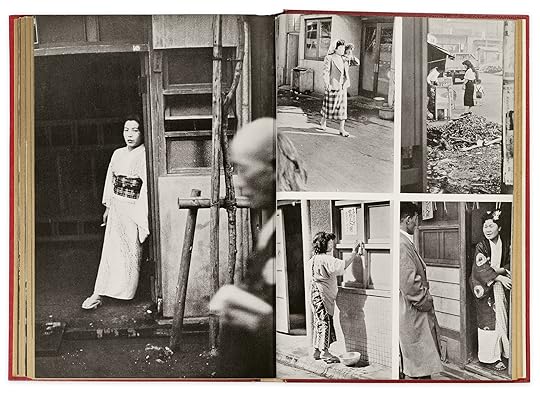 Tokiwa Toyoko, spread from Kiken na adabana (Dangerous poison flowers), 1957
Tokiwa Toyoko, spread from Kiken na adabana (Dangerous poison flowers), 1957 In the postwar era, women’s photographic labor was represented in the Japanese mass media as flexible, temporary labor—a field one might participate in until marriage. Those who did take up photography as a full-time career, such as Tokiwa Toyoko, were often described as exceptional cases and reported on with much curiosity by photography and women’s magazines. Tokiwa became one of the most well-known women photographers of the 1950s for her best-selling book, Kiken na adabana (Dangerous poison flowers, 1957), which details her journey into the field of photography and her dedication to photographing women at work. Tokiwa photographed women in the Tokyo and Kanagawa areas, making visible their labor and commenting on the wide-spread view of them as anomalies. They were varied in their professions, including receptionists, fashion designers, bus drivers, sandwich-board wearers, wrestlers, pearl divers, nude models, and sex workers. Women’s magazines such as Fujin Kōron (Women’s Review) published representations of Tokiwa as an inspirational figure for the generation of women photographers who began to photograph in the 1950s. It was also the main place where Tokiwa’s series Hataraku josei (Working women) was published. This work is another example of how the placement of photographs in women’s magazines, rather than photography publications, has meant that much of this series has long been disregarded by photo historians.
 I’m So Happy You Are Here: Japanese Women Photographers from the 1950s to Now 75.00 A critical and celebratory counter-narrative to what we know of Japanese photography today.
I’m So Happy You Are Here: Japanese Women Photographers from the 1950s to Now 75.00 A critical and celebratory counter-narrative to what we know of Japanese photography today. $75.00Add to cart
[image error] [image error]
In stock
I’m So Happy You Are Here: Japanese Women Photographers from the 1950s to NowEdited by Pauline Vermare and Lesley A. Martin. Text by Takeuchi Mariko, Carrie Cushman, and Kelly Midori McCormick. Contributions by Marc Feustel and Russet Lederman. Photographs by Hara Mikiko, Ishikawa Mao, Ishiuchi Miyako, Katayama Mari, Kawauchi Rinko, Komatsu Hiroko, Kon Michiko, Nagashima Yurie, Narahashi Asako, Ninagawa Mika, Nishimura Tamiko, Noguchi Rika, Nomura Sakiko, Okabe Momo, Okanoue Toshiko, Onodera Yuki, Sawada Tomoko, Shiga Lieko, Sugiura Kunié, Tawada Yuki, Tokiwa Toyoko, Ushioda Tokuko, Watanabe Hitomi, Yamazawa Eiko, and Yanagi Miwa. Designed by Ayumi Higuchi.
$ 75.00 –1+$75.00Add to cart
View cart Description A critical and celebratory counternarrative to what we know of Japanese photography today.I’m So Happy You Are Here presents a much-needed counterpoint, complement, and challenge to historical precedents and the established canon of Japanese photography. This restorative history presents a wide range of photographic approaches brought to bear on the lived experiences and perspectives of women in Japanese society. Editors Pauline Vermare and Lesley A. Martin, curator and writer Takeuchi Mariko, and photo-historians Carrie Cushman and Kelly Midori McCormick provide a critical historical and contemporary framework for understanding the work in three richly illustrated essays. Additional context is provided by an in-depth illustrated bibliography by Marc Feustel and Russet Lederman, and a selection of key critical writings from leading Japanese curators, critics, and historians such as Kasahara Michiko, Fuku Noriko, and others, many of which will be published in translation for the first time. While this book does not claim to be fully comprehensive or encyclopedic, its goal is to provide a solid foundation for a more thorough conversation about the contributions of Japanese women to photography—and an indispensable resource for anyone interested in a more robust history of Japanese photography.
Made possible in partnership with the Rencontres d’Arles and Kering.
Format: Hardback
Number of pages: 440
Number of images: 518
Publication date: 2024-09-17
Measurements: 8.25 x 11 inches
ISBN: 9781597115537
Pauline Vermare is the Phillip and Edith Leonian Curator of Photography, Brooklyn Museum. She was previously the cultural director of Magnum Photos NY, and a curator at the International Center of Photography, the Museum of Modern Art, and the Henri Cartier-Bresson Foundation, Paris.
Lesley A. Martin is executive director of Printed Matter. Previously, she was the creative director of Aperture, where she served as editor on more than one hundred fifty books on photography, and was the founding publisher of The PhotoBook Review.
Takeuchi Mariko is a photography critic, curator, and professor at Kyoto University of the Arts. Previously, she served as visiting researcher at the National Museum of Modern Art, Tokyo, and at the National Museum of Art, Osaka.
Carrie Cushman is the Edith Dale Monson Gallery Director and Curator at the Hartford Art School. She holds a PhD in art history from Columbia University and is a specialist in postwar and contemporary art and photography from Japan. With Kelly Midori McCormick, she was principal investigator and codirector of the website Behind the Camera: Gender, Power, and Politics in the History of Japanese Photography.
Kelly Midori McCormick is an assistant professor at the University of British Columbia. She received her PhD from University of California, Los Angeles, and an MA in East Asian languages and cultures from Columbia University. With Carrie Cushman, she was principal investigator and codirector of the website Behind the Camera: Gender, Power, and Politics in the History of Japanese Photography.
Marc Feustel is a Paris-based independent curator, writer, and editor specializing in Japanese photography.
Russet Lederman is a writer, editor, and photobook collector based in New York. Previously, she taught art writing at the School of Visual Arts and cofounded 10×10 Photobooks.
Related Content Essays The Luminous Openness of Rinko Kawauchi’s Photographs
Essays The Luminous Openness of Rinko Kawauchi’s Photographs  From the Archive Ishiuchi Miyako’s Chronicles of Time and History
From the Archive Ishiuchi Miyako’s Chronicles of Time and History  Featured 7 Essential Japanese Photobooks
Featured 7 Essential Japanese Photobooks Tokiwa’s approach to photographing working women transformed over time, specifically in response to her experiences in red-light districts. When Tokiwa’s exhibition, named for the Hataraku josei series, opened in 1956 at the Konishiroku Gallery in Tokyo, male critics noted that these were photographs that could have been made only by a woman due to the nature of the subject matter. Tokiwa expressed ambivalence over the suggestion that women could make exhibition-worthy photographs only when given the opportunity to enter spaces that male photographers could not. Tokiwa had first photographed sex workers in the red-light district of Yokohama by spying on them from behind bathhouses, through the windows of okonomiyaki shops, and by concealing her camera behind a doctor’s white coat as she pretended to be a nurse in a clinic treating STDs. Hiding, as she later recounted in her bestselling autobiographical photobook, “on the second floor like a hunter taking aim at deer from a blind,” she photographed street scenes in front of unlicensed dealers of Philopon, or methamphetamine. Many of her images, she wrote, reflect the physical, social, and psychological distance she initially felt from those she photographed as she used techniques of photojournalism. Dressing in skirts and geta to blend in with the women, she recounted how “caught in extreme nervousness, divided between fear and skill, I walked in search of my prey (the photographic subject).” Over time, however, Tokiwa’s photographs shifted to reflect how she built relationships with the women of the red-light districts and, through this connection, photographed them from a place of empathy in an attempt to change the popular perception of them as symbols of society’s ills. No longer a photographer who lay in wait to capture an unaware subject, she became a woman faced with the difficulty of making a living in a country recovering from the devastation of total war.
 Ishikawa Mao, Kin, Koza (present-day Okinawa City), Okinawa Prefecture, 1975–77, from the series Akabanaa (Red Flower)
Ishikawa Mao, Kin, Koza (present-day Okinawa City), Okinawa Prefecture, 1975–77, from the series Akabanaa (Red Flower)  Ishikawa Mao, Kin, Koza (present-day Okinawa City), Okinawa Prefecture, 1975–77, from the series Akabanaa (Red Flower)
Ishikawa Mao, Kin, Koza (present-day Okinawa City), Okinawa Prefecture, 1975–77, from the series Akabanaa (Red Flower) Ishikawa Mao saw herself from the start of her career in the women who worked the bars around the American military bases in Okinawa—the subject of her early photography projects, which resulted in the photobooks Atsuki hibi in Kyanpu Hansen!! (Hot days in Camp Hansen!!, 1982) and Firipin (Philippines, 1989). As Ishikawa describes her process: “This is not an infiltration report. I did not intend to take ‘sneak-peek photo’ on the sidelines. I am neither a magazine photographer nor a photojournalist. I started taking photos by involving myself in the situation. It is not only a documentary but also my own emotional record. So working at a bar for African American personnel is important for me. I decided to become a lady in Kin Town.” Even including herself in some of the photographs, Ishikawa adopted an approach that differentiates her work from that of many of her teachers and contemporaries who, though questioning the role of the photographer in creating a photographic document, most often did not see themselves as making photographs from within their own communities. Ishikawa was drawn to these women, stating: “There was a freedom to say what you wanted and to live your own life. That is why these women lived freely; they were joyful, powerful, and strong. Before I knew it I had become one of them.”
Throughout her career, Ishikawa photographed from inside the worlds she inhabited, often accompanying members of Okinawan communities to their home countries to better understand how Okinawa was a point of connection for people across the world. Ishikawa’s extended work depicts the intimacy that emerged during American militarization as a trans-Pacific event, shaping the lives and identities of Okinawan women and men, Black American military men, and Filipina communities. These raucous and tender portraits speak to the “reciprocal solidarity” felt between Okinawans and Black US servicemen in the 1980s. Ishikawa has continued to photograph the American military’s ongoing—at times violent—presence in Okinawa, bringing into focus new angles on the affected communities.
 Ishikawa Mao, Manila, the Philippines, 1989, from the series
Philippine
Dancers
Ishikawa Mao, Manila, the Philippines, 1989, from the series
Philippine
DancersPhotographer Ushioda Tokuko also saw photography as a means to process the world she inhabited. From 1979 to 1983, Ushioda spent the early years of her daughter Maho’s life photographing their lived environment, a period when her career necessarily took a back seat to her responsibilities as a parent. Or did it? Ushioda published these photographs in 2022 only after rediscovering them in the family storage unit, located in the same building where she had made the majority of the images—specifically, in the single-room apartment in a Western-style house where she and her spouse, the photographer Shimao Shinzō, had started their family. Critics have called the two-volume publication, titled My Husband (2022), “highly autobiographical” and, with hesitancy, “domestic” for how it treats and elevates the most mundane, even frustrating, aspects of maintaining a household (piles of laundry, the harsh light of a lamp subdued by a scarf, a refrigerator drawn on by a child) to make them feel deeply imbued with human touch and memory.
 Ushioda Tokuko, Untitled, 1982, from the series My Husband
Ushioda Tokuko, Untitled, 1982, from the series My Husband  Ushioda Tokuko, Untitled, 1983, from the series My Husband
Ushioda Tokuko, Untitled, 1983, from the series My Husband Despite societal expectations that Ushioda focus solely on home life, the content of the images and the fact of their making in the first place are evidence of her commitment to thrive as a photographer in her early years of parenthood, when she was the primary caregiver to Maho. The photographer Nagashima Yurie, herself a mother, was quick to recognize Ushioda’s work as proof of this balancing act: “Even if you spend the vast majority of the day as a mother and a wife,” Nagashima writes in response to My Husband, “those fleeting moments when you can photograph are opportunities to validate your own existence and bring a deep sense of relief.”
Ushioda made all of the photographs in the first volume of My Husband with a medium-format camera, at times requiring a tripod. Her early work with a 35mm handheld camera is, by contrast, closer to the snapshot aesthetic prevalent in Japanese street photography of this era. Ushioda’s compositions differentiate her street photography from that of her contemporaries. She did not discreetly hunt down her subjects, as Tokiwa described her approach in the red-light districts; rather, children and adults alike stopped and participated in having their photographs made by her. As it happens, her transition to photographing objects in the home coincided with an increasing awareness that “the camera could be a weapon” and a sense of doubt related to photographing people.
 Ushioda Tokuko, Untitled, 1974–75, from the series Machi e (Heading into town)
Ushioda Tokuko, Untitled, 1974–75, from the series Machi e (Heading into town)  Ushioda Tokuko, Untitled, 1974–75, from the series Machi e (Heading into town)
Ushioda Tokuko, Untitled, 1974–75, from the series Machi e (Heading into town) Perhaps due to this growing self-consciousness, Ushioda’s portraits of women on the streets are especially powerful, and, as such, were shown in her first solo exhibition at the Shinjuku Nikon Salon in 1976. Its title, Hohoemi no tejō (Handcuffed by a smile), references the suffocating expectations for women to maintain pleasant physical appearances and attitudes in Japanese society. Given this focus, it is difficult not to read the world that Ushioda built in the photographs that now make up My Husband as an act of resistance against the gendered conventions of domesticity. Still, photography scholar Miyuki Hinton has emphasized the importance of not overstating the critical stance of this body of work. As Ushioda herself has reflected, these photographs were made at a time when she was experiencing a sense of unbalance due to the unexpected life she had begun with Shimao and becoming a parent. Photography, then, was a means of looking more closely at this new world as it came into being. Boxed up and forgotten once her daughter went to school and Ushioda was free to work outside of the home again, these photographs now attest to how critical this time was for her to hone her distinct photographic style and technique. They sow the seeds for future projects, such as Reizōko (Ice Box, 1996) and Bibliotheca (2017), which examine with stunning intimacy the highly personalized qualities of otherwise ubiquitous consumer products—refrigerators and books.
The artist Komatsu Hiroko uses photography as a model for how to build a more just and equitable world for all living beings. By her own admission, Komatsu came late to photography. She began her career as an experimental musician and started working with photography in the mid-2000s after participating in a workshop led by Kanemura Osamu, now her partner. Feeling that she needed to “catch up,” Komatsu rented an abandoned retail space in Tokyo from 2010 to 2011 to independently stage a series of exhibitions under the collective title Broiler Space. Forcing herself to mount one new exhibition per month for the entire year, Komatsu quickly ran out of usable space and had to reconsider the parameters of traditional exhibition design. This led to her singular installation method, which expanded out from the walls so photographs were draped across the floor, hung from the ceiling, and, on one occasion, even rolled outside. This material overload acted as a proxy for the photographic subject matter—new-construction and scrap materials that flowed through sites of industry. Unveiling the environmental chaos and excessive waste that undergirds processes of urban renewal, Komatsu created a space to consider the cycles of creation and destruction that define the contemporary Japanese city. In 2018, she received the Kimura Ihei Award in recognition of these interventions.
Advertisement
googletag.cmd.push(function () {
googletag.display('div-gpt-ad-1343857479665-0');
});
 Kanemura Osamu, Exterior of Broiler Space, Tokyo, 2010. Broiler Space was an independent exhibition space run by Komatsu Hiroko from 2010 to 2011.
Kanemura Osamu, Exterior of Broiler Space, Tokyo, 2010. Broiler Space was an independent exhibition space run by Komatsu Hiroko from 2010 to 2011.  Komatsu Hiroko, Jirissokudo sakugo (Self- slowing error, detail), 2021. Installation view of Komatsu Hiroko: Second Decade at Joseloff Gallery, Hartford Art School, University of Hartford, Connecticut, 2022
Komatsu Hiroko, Jirissokudo sakugo (Self- slowing error, detail), 2021. Installation view of Komatsu Hiroko: Second Decade at Joseloff Gallery, Hartford Art School, University of Hartford, Connecticut, 2022 The fact that Komatsu has grown to acclaim as a photographer without a formal education in the medium is a testament not only to her tireless work ethic but also to broader structural, cultural, and social transformations that have made the contemporary art world more accommodating to women. While she does not have to contend with gender discrimination to the same degree as her predecessors, her work functions in part to question the patriarchal and capitalist-driven structures of production and criticism that persist in determining what is of value in the art world today. Since the conclusion of Broiler Space, Komatsu’s massive grids of 8-by-10-inch prints have continued to grow, adapting to the particulars of the gallery and museum spaces around the world in which they are shown. At the same time, she defies and pushes the boundaries of these art institutions by, among other tactics, forcing visitors to walk on and thus destroy her photographs; forgoing condition reports; and neglecting to produce the discrete, self-contained works sought by the art market. This is not to say that Komatsu is not interested in selling her work. Indeed, she creates artists’ books by hand that both economically sustain and conceptually innovate her art practice.
 Komatsu Hiroko, Jirissokudo sakugo (Self- slowing error, detail), 2021. Installation view of Komatsu Hiroko: Second Decade at Joseloff Gallery, Hartford Art School, University of Hartford, 2022
Komatsu Hiroko, Jirissokudo sakugo (Self- slowing error, detail), 2021. Installation view of Komatsu Hiroko: Second Decade at Joseloff Gallery, Hartford Art School, University of Hartford, 2022Whether creating immersive installations or more intimate encounters with artists’ books, Komatsu pushes her materials to their limits, asking important questions about how we produce, consume, and share knowledge; what is taken for granted in those processes; and how we might perceive and construct the world differently going forward. As the scholar Franz Prichard argues, the full-body experience of Komatsu’s installation work plays “a decisive role in opening up the entanglements among shared human and more-than-human worlds to potentially noisy and intensive forms of mutually reparative and regenerative relation,” aligning her work with Sara Ahmed’s definition of feminism. Critical to this practice is a form of world-building that takes the materials of photography as its foundation, thus inverting traditional approaches to photographic history and criticism that prioritize images over material realities and the social, political, and phenomenological worlds that they can engender. Indeed, Komatsu is among a ground-breaking group of contemporary photographers who are doing for photographic practice what an increasingly diverse spectrum of historians, critics, and curators are now doing for photographic history—experimenting with new modes of perception and, to repeat the feminist lesson of Marsha Meskimmon, remaking meaning.
All of these photographers transformed the practice of photography in ways that similarly interrupt longstanding criteria and assumptions about what forms of image-making are meaningful and valuable. They built worlds in the studio, on the streets, in bars, at home, and in the spaces of art institutions. Seen collectively, their work represents a range of approaches to address the power relations inherent in the acts of running businesses, connecting with photographed subjects, and sharing photographic projects with the world. In their acts of connection and self-exploration, and in their reformulations of how viewers experience the medium, each photographer should be seen as essential to the story of photography and the ongoing process of expanding and reconceiving its history.
This essay has been excerpted and edited from a longer version in I’m So Happy You Are Here: Japanese Women Photographers from the 1950s to Now (Aperture, 2024).
I’m So Happy You Are Here: Japanese Women Photographers from the 1950s to Now is made possible with generous support from Kering | Women in Motion, Anne Levy Charitable Trust, and Documentary Arts, Inc.
How Wing Shya Captured the Mood of Wong Kar-wai’s Films
Bodies draped sensuously across ornamental, color-drenched interiors; city scenes blurry with speed and streaking with light: for much of his thirty-year career, Wing Shya has crafted such expressionistic images, first forged amid the heady, creative atmosphere of 1990s Hong Kong. Shya, who came to fame as a set photographer for Wong Kar-wai, has since pursued a prolific career across fashion, music, and film, moving nimbly between art and commercial photography, still and moving images. His latest photobook, Solace, surveys his work from 1997 to now. These include behind-the-scenes photographs from Wong’s film sets as well as snapshots from Shya’s own life and travels in Hong Kong, India, and mainland China.
Solace features images that embrace the effects of accidents and mistakes: expired film, light leaks, blurry focus. Similarly, Shya tends to defer agency to people and forces outside himself: the influence of Wong Kar-wai, the demands of the market, curators and publishers, timing. I recently spoke with Shya about his heterogeneous career as a designer, photographer, and filmmaker; the commercialization of Wong Kar-wai’s aesthetic; and the future of photography in Hong Kong. The following interview has been translated from Mandarin Chinese and edited for concision and clarity.
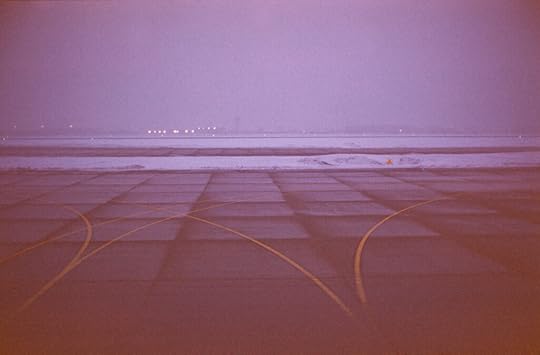
Xueli Wang: I want to start by discussing your new book, Solace. What is the time frame of the photographs in the book? Some look to be from the 1990s while others seem more recent.
Wing Shya: The photographs in the book begin from about 1997 and end from about three years ago.
Wang: Why revisit images from decades ago? What was the impetus behind the book?
Shya: To be honest, I’m not someone who’s very interested in making books. Usually it’s someone else who proposes that I make a book and then I say okay. About four years ago, before the pandemic, I had an exhibition, Happy Together, at Blue Lotus gallery in Shanghai. The curator of that show, Karen Smith, helped me organize that exhibition, and then Shelly Verthime wanted to produce a book of my work, and I said okay. I’m always a bit passive. Usually, I don’t participate in the selection of images either.
For this new book, Miwa Susuda of Session Press wanted to create a book of my work with the designer Geoff Han, so I sent over my photographs for them to select themselves. It’s not that I’m not interested, but rather, I’m open to others’ ideas.
Wang: What about the chronology of the photos and how they’re arranged—did you make those decisions?
Shya: No, nothing. In fact, I’m more interested in the way other people view my work. I want to know how others think, what they like. Sometimes the creative process of a photographer is very lonely—you don’t know how outsiders see your work. So for Geoff to say, “I like this one or that one,” was helpful to me. I sent thousands of photographs.
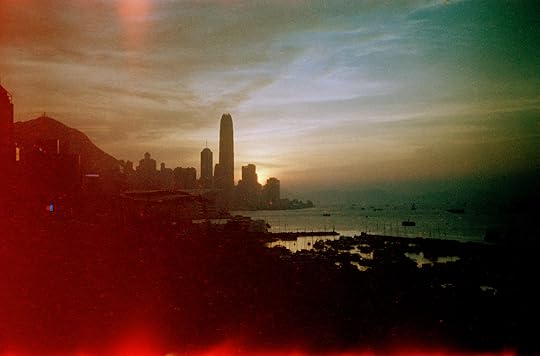
Wang: The book opens with photographs from India and Hong Kong. Were these taken recently?
Shya: The first photo, taken in India, is from about eight years ago. I had traveled there to visit Buddhist temples and began taking photographs in the morning, as soon as I woke up. The second photograph was taken in Hong Kong, about six to seven years ago, from a mountain peak at dusk in Kowloon. These were taken in my free time, not for work. In terms of chronology, the photographs are all mixed together. I take my camera with me everywhere. When I come across a scene that feels cinematic, I photograph it.
Wang: I’m sure you get this question a lot, but how did you come to collaborate with Wong Kar-wai? And how did your relationship evolve?
Shya: When I came back to Hong Kong after graduating university, I did not have a good sense of the fine arts scene. I got a job as an art director at the company Double X Workshop, which produced music records. My boss at the time was an actor, DJ, and filmmaker, Eric Kot Man-fai. He was starting to make his first film, First Love: Litter on the Breeze, produced by Wong Kar-wai’s new production company, Jet Tone Films. Eric introduced me to Wong as a set photographer because I was the company’s in-house person. But I told Kar-wai: I don’t know much about photography, only simple stuff. Despite that, he asked me to show him a portfolio.
It was a matter of timing. After I finished shooting set photography for Eric’s film, Kar-wai was making a commercial for the Japanese fashion designer Takeo Kikuchi and asked me join for the shoot for two to three days. So I worked as a set photographer for that commercial, but I wasn’t the main set photographer. Wong had also hired a photographer from Japan, while I was the in-house photographer he brought with him from Hong Kong. Afterward, for whatever reason, they chose one of my photographs for the poster. Soon after, Wong was heading to Argentina to shoot his next film Happy Together and he asked my boss if I could go with them for two to three months.
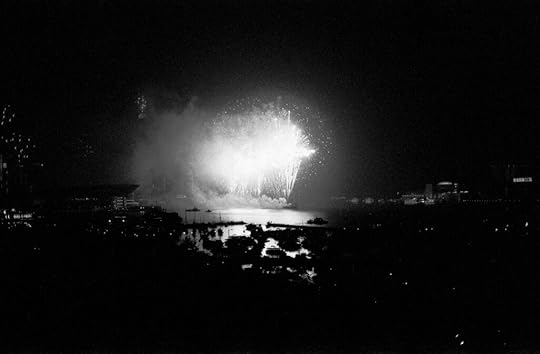
Wang: What was it like working on the set of Happy Together? Did you and Wong have differences in style?
Shya: I was just an insignificant photographer, one among several. I wasn’t on the same level as Wong Kar-wai and also didn’t know much about photography. I went there with my small camera and began shooting with that. On the set, my camera shutter kept clicking and the sound person came and yelled at me. He asked, “Why don’t you have a silencer box to mute the shutter?” I had never heard of such a thing. After that, Wong asked someone to order me one. It had to be tailor made and the wait time was three months. By the time I received it, the film had already finished shooting and we were heading back to Hong Kong.
The whole time I didn’t dare shoot during “action” because of the noise. I couldn’t photograph when the camera was rolling, so I could only photograph behind-the-scenes moments, before and after the actual performance. I would sneak shots of actors on break. I only photographed the “making of” the films, never during the “action,” because I got used to shooting in this way.
Wang: It’s true, many of your photographs from his films actually fall outside the purview of the films themselves. You snuck candid shots of the actors before they were quite ready for the camera. For example, there’s a photograph in the book, a back silhouette of Maggie Cheung smoking alone in a cab. Is this a photograph of Maggie Cheung as herself, rather than her character in In the Mood for Love?
Shya: This is a photograph of Maggie as herself. Her character did not smoke in the film. She also did not ride in the cab alone in the film. Often times, I liked to sneak candid shots. I liked to catch actors when they weren’t ready because they’re in a different state. They’re in a state of rest.
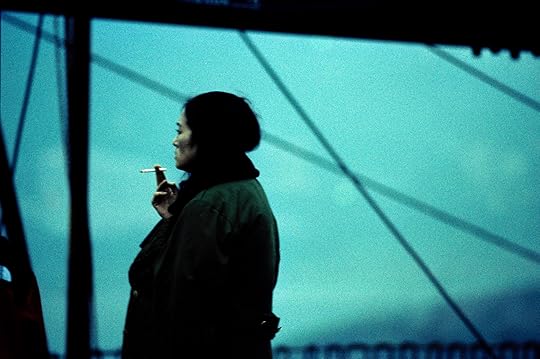
Wang: Did you establish a rapport with the actors you photographed?
Shya: There wasn’t much communication at all. We weren’t in the same class [laughs].
Wang: Did they mind you sneaking shots of them off set?
Shya: They got used to me photographing candids. I once did have some conflict with Leslie Cheung though. In Happy Together, Leslie had a scene at a train station. The director said the station was too loud, so they didn’t record audio. Because of that, I could shoot on set. I shot a lot. But in that scene, Leslie’s character was in a bad mood. He had to conjure that emotional state while I was clicking away nearby and finally he started yelling at me to be quiet.
I approach these photoshoots like a film. I think about the actor, time period, the setting. I think like a director with a script in mind.
Wang: But you must have left an okay impression, since Wong invited you back to photograph on the set of In the Mood for Love and 2046.
Shya: Actually, I never felt fully qualified. But I was happy to be invited to go photograph. I always felt Wong Kar-wai had very high standards.
Wang: Do you feel there’s a stylistic difference between your photography and Wong’s filmmaking?
Shya: I feel I’ve always been emulating his work. I didn’t dare talk to Wong, so I asked Christopher Doyle, Wong’s cinematographer, “How should I take set photographs?” He said, “Watch the monitor. Follow my framing.” I spent a lot of time behind the director, watching his monitor.
Kar-wai had said that it was better for the set photography to share the aesthetic of the film. It’s not really imitation, but following the same framing as the film. But I would sneak shots of other things too. For example, in the book, there are a pair of photographs from In the Mood for Love that are outside the frame of Wong’s film. They capture moments of rest on set.
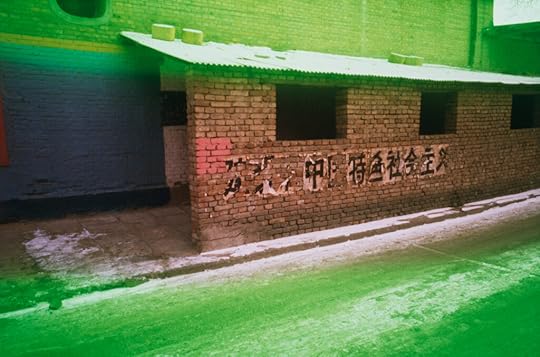
Wang: Let’s go back to the beginning. You grew up in Hong Kong and studied in Canada for university. Why did you decide to return to Hong Kong after that?
Shya: After graduating from Emily Carr University of Art and Design in Canada, I started a company with some classmates. I majored in graphic design, so our firm specialized in design. We didn’t have many clients, but we had enough. One day, in 1991, I went with some classmates for breakfast in Chinatown and afterward I passed by a newsstand with some magazines from Hong Kong. I began looking through them and thought to myself, “Wow, the design here looks terrible!” Given that I had some fine arts training, I thought it would be a special time for me to be there; it would be something different; I wanted to participate. So I told my classmates, “The state of design in Hong Kong seems terrible, I want to return there to work.” Within a week, I had sold my furniture and my car and was on a flight to Hong Kong.
Wang: Today, we look back at Hong Kong in the 1990s as a kind of golden age of cultural production in film, music, art, fashion. In the years leading up to the 1997 handover, the city hit peak creativity.
Shya: Yes, everyone participated. We didn’t know at the time that it was a peak. I thought it would always be that way. I didn’t understand many things. The market was rich and abundant. There was a strong sense of the future. Even though I was naïve, I think my design sense was at its strongest. I didn’t care about money. I just wanted to work, to create. I think I made my best work back then.
Wang: When did you get seriously into photography?
Shya: After I returned to Hong Kong, in 1991, I was awarded first place in a biennial arts competition. After that, some magazines asked me to photograph for them. Most of them were fine art publications. I would get two to three such assignments a year, not many. The portfolio Wong Kar-wai saw was mostly images from these freelance assignments.
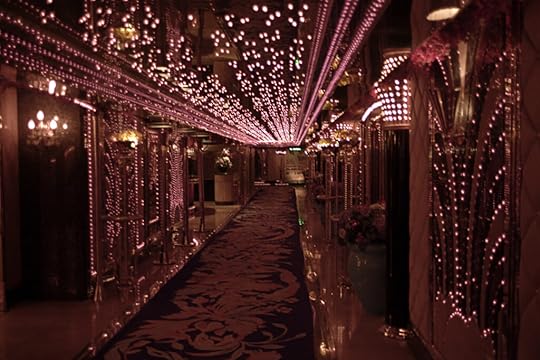
Wang: Did your collaborations with Wong Kar-wai influence how you approached subsequent projects?
Shya: Of course. I returned to Hong Kong in 1991 and began working with Wong Kar-wai in 1996. In the intervening five years, I did mostly fine art photography. Occasionally I photographed for music albums. If they really couldn’t find a photographer, or didn’t have the budget, they’d ask me. Very small assignments. After working with Wong Kar-wai, people from Japan began reaching out to me. One Japanese woman reached out and became my manager. So, around 1997, I began shooting for Japanese magazines.
In Hong Kong, I still spent most of my time working with Wong Kar-wai. I didn’t have much time for anything else. But there were a lot of records being produced in Hong Kong. Every week there were new album releases, so I had many opportunities to do photoshoots of album covers. Because of that, I met many singers.
Wang: Did you see a distinction between commercial and art photography?
Shya: For the album covers, I didn’t always know what they were looking for. At first I approached it like fine art photography. I didn’t understand things like studio lighting. Early on, I’d do it very simply, with just a small camera, then someone told me I needed to use flash and other kind of lights, so I began learning about lighting from photography assistants. From 1997 onward, I became more familiar with the language of commercial photography. I learned as I worked.
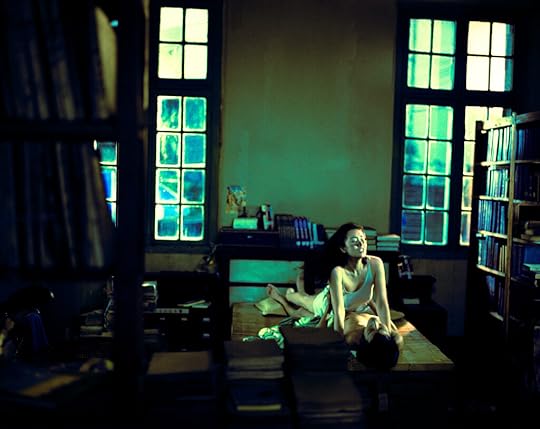
Wang: Did working on film sets inform your approach to still photography? Did you create images with a narrative in mind?
Shya: Working on album covers had familiarized me with commercial photography. But when I started working for fashion magazines, my approach changed. In Paris, I met the founder of i-D magazine, Terry Jones. When we met, I showed him a book of stills from Happy Together and he asked me to work on fashion shoots for him, in Hong Kong, in that style. So I began using a film set approach to fashion photography. I worked for i-D for a long time.
Wang: Around 2001, you began making more moving image works—videos and films.
Shya: Yes. In 2001, I began shooting commercials in Singapore. So my collaboration with Wong Kar-wai launched me into different kinds of work. In fact, I don’t feel like I have any single style. When I went back to Hong Kong, in 1991, I didn’t know anything, and since then I’ve just been learning. Even now I’m still learning. I still feel like I don’t fully understand this work.
Wang: In 2010 you made your first movie, Hot Summer Days.
Shya: It came out of my work as a set photographer. While on assignment for a film director friend, I met the project’s scriptwriter, Tony Chan, and we decided to work on a script together. It just so happened that 20th Century Fox was looking to make a Chinese-language film set in Hong Kong. They liked our script and we began shooting right away.
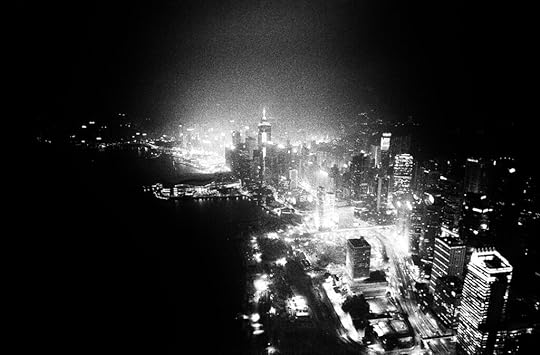
Wang: You’ve worked in Hong Kong as a photographer for over three decades. During this time, Hong Kong has seen enormous changes and upheavals. Have these changes influenced your practice and the way you relate to the city?
Shya: Hong Kong has changed a lot, and I have too. The changes that have come in terms of my own work have to do more with a change in feeling than a change in the city. Back then, there was such a strong sense of the future. It felt like there were endless things to photograph, so much of the future ahead of us. But later, there were fewer music records being released, the market changed, and now the city doesn’t quite have the same sense of vitality.
Wang: Are you working on any new projects now? Has your own style changed?
Shya: Yes, a variety of things. I’m working on some film scripts and directing some commercials. For a while I stopped making commercials because I was too tired. It’s more comfortable for me being a feature film director. As for my own style, many people have described it as cinematic, but I don’t really have a style. I just do what works for me, what I’m used to. The commercials I make, for example, they don’t really have a style. I need to survive. After I opened my studio, I had many employees I needed to take care of. So I took on whatever project I could—I made Pepsi commercials for ten years, for instance. Often I can’t afford to have a style. I must work to earn a living, to support my family. But when I do get the opportunity to do a more artistic shoot, for example for i-D, I tend to approach it cinematically.
Wang: Cinematic in what way?
Shya: I approach these photoshoots like a film. I think about the actor, time period, the setting. I think like a director with a script in mind. Sometimes I’m not shooting actors but models. When I tell them I’ve written out a script or role for them, the model would tell me “I’m not an actor.” But I tell them to follow my lead and just think about the scenario I’m imagining.
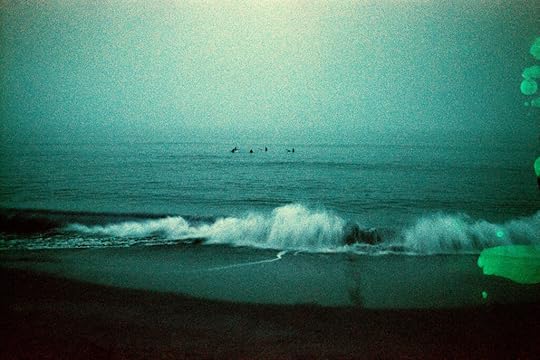 All photographs by Wing Shya, 1997–2021, from Solace (Session Press, 2024)
All photographs by Wing Shya, 1997–2021, from Solace (Session Press, 2024)Courtesy the artist
Wang: Is this a common approach for magazine photo shoots? Do you actually write out a script beforehand or think of the scenario on the day of the shoot?
Shya: No, not common at all. I write out a script beforehand. Usually, I first pick the city—for one shoot, I picked Beijing—then I look for the actor and location. To do this, I first look for the right music—this is something I learned from Wong Kar-wai. Before making a film, he would invite me to his room to listen to music. I didn’t understand why at the time, but later it became my routine. The movement of the music matched the movement of the camera. This became my process for photographing too. For example, for the Beijing shoot, it was a rock-and-roll story, so I listened to rock music. I work like this when making films too. After writing the script, I make a playlist that I share with the cinematographer.
Wang: You’re working on the script for a new film now?
Shya: Yes, but I’m also shooting commercials, about two to three a year.
Wang: What’s the film script about?
Shya: It’s set in Tokyo. A story between a mainlander and a Japanese character. I don’t really know much about scriptwriting. In fact, I’m always the passive one—in my commercial work too. I don’t actively seek out new work. People usually come find me. If no one comes then I just stay home, read, and rest. I’m actually quite lazy [laughs].
Wing Shya: Solace was published by Session Press in 2024.
September 19, 2024
Robert Frank’s Genre-Bending Collaborations with Musicians
Robert Frank spent the summer of 1972 crisscrossing America—not in pursuit of the lyrical social documentary for which he was already famed, but as part of the Rolling Stones’ forty-eight-date mobile bacchanal. It had been three years since the disastrous show at the Altamont Speedway, and the band was stateside again, on the heels of a recording session in the south of France that is now etched in the annals of debauched rock excess. The tour was no exception—sex and drugs and everything else, all later mordantly recounted by Truman Capote to Andy Warhol in the pages of the magazine named for the group. The novelist registered his surprise that so much of it was unabashedly documented, that Frank was always there, camera at hand.
 Robert Frank, Cocksucker Blues, 1972
Robert Frank, Cocksucker Blues, 1972In many ways, the tour marked a return for Frank as well. From 1955 to 1957, he made eighty-three pictures that would be published the following year in Europe as the book The Americans, and republished in 1960 with an introduction by the then quintessential avatar of the road trip, Jack Kerouac. The Beat wanderer observed that a musical quality suffused Frank’s frame—the Swiss-born photographer was drawn to the country’s lonely jukeboxes, people swaying at roadside dives, or riders in a convertible, ablur in motion. The book encapsulated the broad humanism and compositional immediacy that drove art photography well into the 1960s, solidifying Frank’s status among a younger generation (including his lifelong friend Danny Lyon) as a lodestar who chronicled a turbulent era.
 Tom Waits, Rain Dogs, 1985
Tom Waits, Rain Dogs, 1985  Rolling Stones, Exile on Main Street, 1972
Rolling Stones, Exile on Main Street, 1972 The trouble with finding such success early on is that one’s career is always measured against it, before and after. Ironically, the vast majority of Frank’s varied output in photography, film, and performance, and his participation in the electric Lower Manhattan scene of the 1960s, happened after The Americans. But those genre-bending collaborations are lesser known—an imbalance that the Museum of Modern Art’s current show Life Dances On: Robert Frank in Dialogue seeks to correct. Certainly, his episode with the Stones was but a high-profile instance of the ways in which Frank was less a lone photographer and, instead, a connector in a larger creative milieu. When he visited the band in LA, where they were wrapping Exile on Main Street, everyone seemed to click, and Frank was invited to shoot and design elements of the LP art (he had already captured stirring images for the mountain-folk outfit the New Lost City Ramblers) and to make an entry in the now venerable genre of auteurist concert film.
In those days, albums were events, gatefolds and liner notes scrutinized with Talmudic attention. For Exile on Main Street, Frank photographed the Stones in LA and New York but also interspersed older pictures, collaging and overlaying them with text. The iconic cover sequence of Arbus-esque carnival performers was actually a single image from The Americans rolls of the 1950s, taken from a board displayed at Hubert’s Flea Circus and Museum on West 42nd Street. The photograph was already well-known by misleading titles such as Tattoo Parlor, 8th Avenue, New York City. As RJ Smith noted in his biography of Frank, the shifty titling foreshadowed the sort of visual remixing at play on the Exile on Main Street cover and throughout the photographer’s career. Frank seemed keen to dirty up his image before it settled into hagiography, letting the meaning of his pictures drift by putting them in new contexts.
Related Items

Robert Frank: The Americans
Shop Now[image error]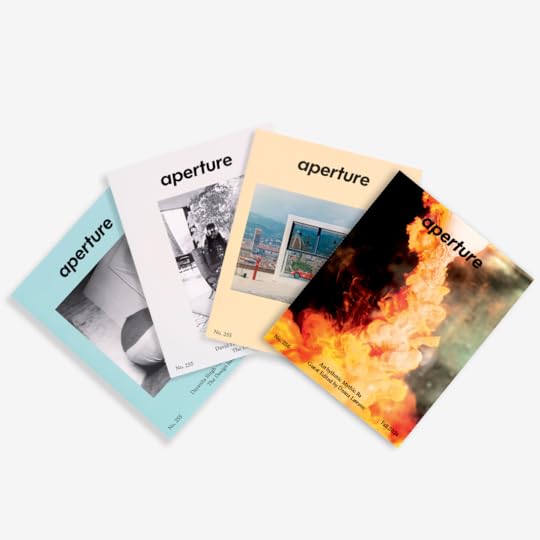
Aperture Magazine Subscription
Shop Now[image error]Musicians liked Frank because he turned a sympathetic eye to the margins of the American experience, foregrounding its grubbier contours. Although much of his later life was spent in the artists’ enclave of Cape Breton, Nova Scotia (alongside Joan Jonas, Richard Serra, and JoAnne Akalaitis), Frank always kept one foot in the Bowery, often turning up at haunts such as CBGB, where he met Patti Smith. The photojournalist Ted Barron recalls stumbling upon him in Tompkins Square Park one day in 1985, crouched on the pavement to capture a dashingly coiffed Tom Waits in conjunction with the Rain Dogs album. Waits was then cast in Frank’s 1987 feature made with Rudy Wurlitzer, Candy Mountain, about another road trip—a quest to Nova Scotia in search of a reclusive guitar luthier.
 Still from Summer Cannibals, 1996. Four minutes, six seconds, black and white, sound
Still from Summer Cannibals, 1996. Four minutes, six seconds, black and white, soundAll images courtesy the Museum of Modern Art, New York; the June Leaf and Robert Frank Foundation; and Pace Gallery
That sort of recurrence of old acquaintances in new guises is a common thread in Frank’s many projects over the years. He met the British actor David Warrilow in 1975, and cast him in the full-color music video for New Order’s lesser-known 1989 track “Run.” More striking still was Frank’s collaboration with Smith on the music video for her 1996 song “Summer Cannibals.” Here, the roving lens and warped angles developed in his earlier stills inform his cinematic approach: they made Frank’s style feel newly fresh, and also of a piece with a host of black-and-white videos emblematic of the form’s maturation during the early 1990s. Both projects were typical examples of reinvention through tuning into the frequencies of other creators. In this way, the MoMA show reminds us that the shopworn tale of the solitary genius artist is rarely true: those icons always get by with a little help from their friends.
This article originally appeared in Aperture No. 256, “Arrhythmic Mythic Ra.” Life Dances On: Robert Frank in Dialogue is on view at the Museum of Modern Art, New York, through January 11, 2025.
September 12, 2024
Louis Carlos Bernal’s Intimate Portrayals of the Chicano Experience
Best known for his intimate portrayals of barrio communities of the Southwest United States, Louis Carlos Bernal made photographs in the 1970s and 1980s that draw upon the resonance of Catholicism, Indigenous beliefs, and popular practices tied to the land. For Bernal, photography was a potent tool in affirming the value of individuals and communities who lacked visibility and agency. “My images convey the spiritual and cultural values of the Chicano experience,” he once said.
The recent book Louis Carlos Bernal: Monografía is copublished by Aperture and the Center for Creative Photography (CCP), coinciding with a solo exhibition curated by Elizabeth Ferrer for CCP at the University of Arizona in Tucson. As Ferrer notes in her expansive essay for the book, “Bringing his full self to his work was Bernal’s longstanding aspiration, and he understood the process of making a photograph as a complex synthesis of the physical and the mechanical, the visual and the psychological.” Working in both black and white and in color, Bernal photographed the interiors of homes and their inhabitants, often presenting his subjects surrounded by the objects they lived with—framed portraits of family members, religious pictures and statuaries, small shrines festooned with flowers, and elements of contemporary popular culture. Bernal viewed these spaces as rich with personal, cultural, and spiritual meaning, and his unforgettable photographs express a vision of la vida cotidiana—everyday life—as a state of grace.
Louis Carlos Bernal: Monografía is entirely bilingual in English and Spanish, and includes a detailed chronology of Bernal’s life and work, with images of the photographer as a young man, his exhibition posters, and other never-before-seen documents from his archive. Ferrer, the author of the groundbreaking book Latinx Photography in the United States: A Visual History (2020), recently spoke with Elianna Kan, who translated Monografía into Spanish, about Bernal’s work on the border between the US and Mexico, his pioneering use of color, and why his photographs belong in the canon of American photography.

Cover and spread from Louis Carlos Bernal: Louis Carlos Bernal: Monografía (Aperture/Center for Creative Photography, 2024)
var container = ''; jQuery('#fl-main-content').find('.fl-row').each(function () { if (jQuery(this).find('.gutenberg-full-width-image-container').length) { container = jQuery(this); } }); if (container.length) { const fullWidthImageContainer = jQuery('.gutenberg-full-width-image-container'); const fullWidthImage = jQuery('.gutenberg-full-width-image img'); const watchFullWidthImage = _.throttle(function() { const containerWidth = Math.abs(jQuery(container).css('width').replace('px', '')); const containerPaddingLeft = Math.abs(jQuery(container).css('padding-left').replace('px', '')); const bodyWidth = Math.abs(jQuery('body').css('width').replace('px', '')); const marginLeft = ((bodyWidth - containerWidth) / 2) + containerPaddingLeft; jQuery(fullWidthImageContainer).css('position', 'relative'); jQuery(fullWidthImageContainer).css('marginLeft', -marginLeft + 'px'); jQuery(fullWidthImageContainer).css('width', bodyWidth + 'px'); jQuery(fullWidthImage).css('width', bodyWidth + 'px'); }, 100); jQuery(window).on('load resize', function() { watchFullWidthImage(); }); const observer = new MutationObserver(function(mutationsList, observer) { for(var mutation of mutationsList) { if (mutation.type == 'childList') { watchFullWidthImage();//necessary because images dont load all at once } } }); const observerConfig = { childList: true, subtree: true }; observer.observe(document, observerConfig); }Elianna Kan: I love this quote that you include in your essay in the book, from a 1984 interview in which Bernal recounts his move to Tucson and the cultural values of the barrios: “During the physical move, I also began a spiritual move back to the barrio and a new attitude toward life—Chicanismo. Mexican-American is the term used to describe a person who is of American birth, but whose cultural soul derives from Mexico. This dual reality has been a burden which has clouded our identity. Chicanismo allows us to accept our history but also gives us a new reality to deal with the present and the future.” This passage speaks to the trajectory of Bernal’s career. In spending all this time with Bernal’s work, how do you see his particular relationship to Chicanismo?
Elizabeth Ferrer: Well, there’s a lot to unpack there. Bernal was born in 1941 in the town of Douglas, Arizona, which is right on the border between Mexico and the United States. When he was a young boy, his parents were poor. His mother was a maid; his father was a boilermaker. They eventually moved to Phoenix where they rose into more of a comfortable working class. They were strivers. They were always very proud of their identity as Mexican Americans. One of the things that the family took great pride in with their children was the ability to speak Spanish. So they were always proud of their culture and in that way, but it was really with Bernal, in the early 1970s, that he begins to see his culture in more contemporary and political terms. When he decided that he wanted to become a photographer, his goal was really to become an artistic photographer, not a photojournalist, not a documentarian.
In terms of the Chicano civil rights movement, the photography that he would’ve seen in the early ’70s, when he was in graduate school, was protest photography. Photography made by volunteers for the farmworkers’ movement; photographs of protest, rallies, and demonstrations; and portraits of Cesar Chavez, that kind of thing. But when Bernal was talking about Chicanismo, he was thinking about wanting to express the spiritual core of people. When he was in graduate school, in the early 1970s, he produced some interesting experimental work. This was the time when photography was really breaking out of the box. A lot of young photographers were questioning the ideas of pure photography or so-called straight photography, and he was working with a number of approaches to manipulation, constructing scenes for the camera, working with double exposures.
When Bernal moved to Tucson, he had a realization that he wanted his art to be for the people. And he decided that what he wanted to do, very simply, was to photograph his own people. These were people that were not accustomed to being photographed in this way. In those days, Mexican Americans were often denigrated, and when they were photographed, it was often to show them in an ethnographic or stereotypical way. Bernal wanted to express this sense of spirituality, this dignity, this pride that he had. So he developed his own mode of photography, which, for me, is quietly political. With every photograph that he’s taking of every Mexican American person, he’s making a political statement. He’s saying, Look at this person. This person has dignity. This person should not be overlooked.
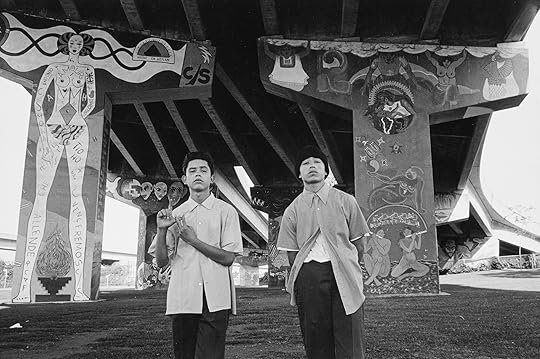 Louis Carlos Bernal, Cholos, Logan Heights, San Diego, 1980
Louis Carlos Bernal, Cholos, Logan Heights, San Diego, 1980  Louis Carlos Bernal, Santos y Television, Mexico, 1981
Louis Carlos Bernal, Santos y Television, Mexico, 1981 Kan: What was Bernal’s relationship to other photographers in the art world?
Ferrer: Bernal was actually quite a good historian of photography. When he went to Pima College in 1972 to launch the photography department there, he taught studio work, he taught darkroom and the history of photography. He also studied with the photographer Frederick Sommer while he was a graduate student. Some of his work actually comes under Sommer’s influence, but that influence is something he eventually had to separate himself from.
Bernal began to use color in his photography around 1978, after he received a commission for a publication and exhibition called Espejo, which was meant to be a broad view of Mexican Americans in the United States. He received a large grant to produce the photographs. He had done some work in color earlier, but it was expensive. He was always very conscious of his limited budget. That project gave him the opportunity to work more consistently in color. There were other people at that time who were working in color as well, like Stephen Shore, who has a reputation as being one of the very first artistic photographers to work in color; before then, color was seen as the province of magazine ads and commercial photography. Bernal was working in color at the same time as Shore was, but he didn’t get recognition for being a pioneer in that way.
Advertisement
googletag.cmd.push(function () {
googletag.display('div-gpt-ad-1343857479665-0');
});
Another element of context is Mexican photography. Bernal went to Mexico as early as 1962 in order to improve his Spanish. When he was young, he thought he might become a Spanish teacher. The earliest photograph in the show is from 1962, made during his first trip to Mexico. In the 1980s, he begins to go to Mexico City regularly, and he attends these major colloquiums of Latin American photography that happened at that time. They were watershed events because they brought together, for the first time, photographers from throughout Latin America so they could meet each other. These events created this idea of Latin American photography.
Bernal went to represent the Chicano voice, to be a Mexican American in that midst, to create a bridge between Mexico or Latin America and Mexican Americans in the United States. He met important Mexican photographers including Manuel Álvarez Bravo and Lola Álvarez Bravo. He met his contemporaries, like Graciela Iturbide. If you look at his work made in Mexico in the ’80s, he really seems to come under the spell of Mexican street photography, the focus on Indigenous people, on the urban poor. He works differently always when he travels. He carries his Leica, he works in black and white. This idea of the more posed or intentional image that we see in his interior views in Tucson in the Southwest—he departs from that to work out in the street to photograph. You can certainly see the influence of somebody like Manuel Bravo, who’s often capturing everyday scenes as a means of creating a kind of allegory or to posit a philosophical statement. Bernal does the same thing when he goes to Mexico.
 Louis Carlos Bernal, Dos Mujeres, Douglas, Arizona, 1978
Louis Carlos Bernal, Dos Mujeres, Douglas, Arizona, 1978  Louis Carlos Bernal, Retrato de Boda Rosa, 1978
Louis Carlos Bernal, Retrato de Boda Rosa, 1978 Kan: You mentioned color. That, too, is such an aspect of everyday street life in Mexico. It becomes an essential tool and language, I think, in Bernal’s photography. Can you speak more about the texture and the way that Bernal uses color in his photographs?
Ferrer: Bernal was a master in black and white, a master black-and-white printer. He also taught the zone method. So he understood black and white in a very technical way and in an aesthetic way, but he was attracted to color. I think part of it is just his own community: going into the Tucson barrios and into people’s homes and seeing explosions of colors, bright-pink walls and mismatched upholstery, and also these amazing displays on the walls, home altars with pictures of Jesus and Mary and saints on the walls and dried flowers. He wanted to capture that, but he doesn’t really talk about color in the more stereotypical way that we talk about color when we talk about Latino or Mexican culture.
Bernal wanted to capture what he thought was the spiritual tenor of people, and he thought color brought that out more. Color is not just descriptive; for Bernal, it created a mood. There’s one photo that always stands out for me, Retrato de Boda Rosa (Rosa’s wedding portrait). Bernal photographed an expanse of pink wall; there’s a very small portrait of Rosa in her wedding dress on the wall. It’s almost incidental. I think we get a better sense of how people lived compared to if this photo had been in black and white. Bernal saw color as something psychological.
With every photograph that he’s taking of every Mexican American person, he’s making a political statement. He’s saying, Look at this person. This person has dignity.
And of course, there’s so many fabulous photos that he made that really work with the color, like the photograph Dos Mujeres (Two women), which is on the cover of the book. We see women in two different rooms, and each room has a different color. Bernal really plays off that to create the psychological sense of these women inhabiting these joined but separate spaces. So he became a master of color as well, I think. However, this was an early period for art color photography and the color in a lot of his prints has degraded considerably.
We reprinted some of those images for the exhibition. Digital scans were made from the original negatives, and it is just amazing to see the colors, the way they pop I think that for Bernal, color was a way to go in deeper, to create images in a new way. I think the black-and-white photographs in comparison would’ve seemed like an abstraction of reality to him. With color, he was capturing the layers of these worlds, these small worlds. We’re talking about modest homes and small bedrooms and living rooms.
 Louis Carlos Bernal: Monografía 50.00 A landmark survey of one of the most significant American photographers of the twentieth century.
Louis Carlos Bernal: Monografía 50.00 A landmark survey of one of the most significant American photographers of the twentieth century. $50.00Add to cart
[image error] [image error]
In stock
Louis Carlos Bernal: MonografíaPhotographs by Louis Carlos Bernal. By Elizabeth Ferrer. Text by Rebecca Senf. Designed by Duncan Whyte.
$ 50.00 –1+$50.00Add to cart
View cart Description A landmark survey of one of the most significant American photographers of the twentieth century.Best known for his intimate portrayals of barrio communities of the Southwest United States, Louis Carlos Bernal made photographs in the late 1970s and 1980s that draw upon the resonance of Catholicism, Indigenous beliefs, and popular practices tied to the land. For Bernal, photography was a potent tool in affirming the value of individuals and communities who lacked visibility and agency. Working in both black and white and in color, he photographed the interiors of homes and their inhabitants, often presenting his subjects surrounded by the objects they lived with—framed portraits of family members, religious pictures and statuaries, small shrines festooned with flowers, and elements of contemporary popular culture. Bernal viewed these spaces as rich with personal, cultural, and spiritual meaning, and his unforgettable photographs express a vision of la vida cotidiana—everyday life—as a state of grace. The first major scholarly account of Bernal’s life and work by the esteemed historian Elizabeth Ferrer, Louis Carlos Bernal: Monografía is the definitive book about an essential photographic artist.
Copublished by Aperture and the Center for Creative Photography, Tucson Details
Format: Hardback
Number of pages: 220
Number of images: 166
Publication date: 2024-06-11
Measurements: 8.7 x 10.7 x 1 inches
ISBN: 9781597115575
“In a career spanning only two decades, he produced a body of work that constitutes a Chicanx imaginary, a worldview absent of discrimination and marginalization. He found a way to put Chicanx people at the center of this world, indelibly memorialized.”—High Country News
Contributors
Louis Carlos Bernal (born in Douglas, Arizona, 1941; died in Tucson, 1993) was a pioneering Chicano photographer active in the last quarter of the twentieth century, maturing as an artist in the wake of the 1970s civil rights era. After completing his MFA at Arizona State University in 1972, he joined the faculty of Pima Community College in Tucson, where he developed and led its photography program, and remained for the duration of his career. The Center for Creative Photography at the University of Arizona, Tucson, preserves the Louis Carlos Bernal Archive, including fine prints, project records, correspondence, and clippings.
Elizabeth Ferrer is a writer, curator, and arts activist. She is the former vice president of contemporary art at BRIC in Brooklyn. Ferrer is the author of Latinx Photography in the United States: A Visual History (2021) and curator of the traveling exhibition of Bernal’s work from the Center for Creative Photography, Tucson, set to open in 2024.
Rebecca Senf is chief curator at the Center for Creative Photography, Tucson. She is author of Reconstructing the View: The Grand Canyon Photographs of Mark Klett and Byron Wolfe (2012), Betsy Schneider: To Be Thirteen (2017), Making a Photographer: The Early Work of Ansel Adams (2020), and editor of Richard Avedon: Relationships (2022).
Duncan Whyte is an independent graphic designer from London, living and working in France. His most recent work includes the first volume of Somnyama Ngonyama (Aperture, 2018) and Flint Is Family in Three Acts by LaToya Ruby Frazier (2022) and Baldwin Lee (2022), both of which were shortlisted for Paris Photo–Aperture PhotoBook of the Year.
 Essays The Latina Curators and Writers Remaking the American Photography Canon
Essays The Latina Curators and Writers Remaking the American Photography Canon  Photobooks A Dark and Lyrical Vision of Latin America
Photobooks A Dark and Lyrical Vision of Latin America Kan: I’m interested in those intimate spaces and, specifically, this meta narrative that you draw attention to in your essay on the significance of photography in these homes.
Ferrer: Early on, when Bernal departed from the more experimental work, he often worked with his daughters or with family members. He was beginning to photograph people in their spaces. He decided to venture out into the barrios—Tucson is well known for these neighborhoods that are all close to the center of the city. The oldest barrios, at least at that time, had homes that dated to when Arizona was still part of Mexico. They’re very powerful expressions of Mexican American identity.
Bernal began to wander with his camera. He was gregarious. He knew how to strike up a conversation with these people. He once noted that he was amazed by how easily people would allow him into their homes. Not only would they allow him into their homes, they allowed him into their bedrooms. That gives us some indication of the warmth of Bernal’s warmth and ability to connect with people.
You can get an indication of how he worked from his contact sheets. He worked pretty quickly. He went inside a home sized up what he saw. He would sometimes open doors, open curtains, close curtains. I don’t think he rearranged rooms, but he needed to make the most out of available light and space. And he got to work. He would often make only a handful of exposures. You can see, for example, hoe he worked with a family group. In one frame you see a mom and dad and a couple kids or something like that. There’d be some exposures where just one person is in the frame and others where two or three people are in the frame, or he’s shifted the angle.
He knew what he’d find inside these homes. He knew he’d see religious objects, home altars, or framed pictures of Jesus or the Virgin Mary. He knows that there are family photos. I think that’s so important because Mexican Americans have always taken great pride in family. When you’re dealing with an immigrant population, the portrait on your wall might be somebody you haven’t been able to see for twenty years, or it might be an ancestor, a prized photo that’s been carried through generations. Those are the elements he uses to frame his own compositions. He frames them in a way to tell us about how these people live, what they value, and again, the spiritual dimension through those objects.
Eventually, Bernal begins to also take photographs of these interior spaces without the people. I think that’s really interesting because these are also portraits, but they’re portraits without faces. They’re portraits with objects. Again, the furnishings, the altars, the kitsch, and these family photos. For me, some of those photographs are the most poignant when you see these bedrooms, very, very modest rooms, with elaborate altars that are heavy with crucifixes and saints. His friend, the photographer Armando Cristeto, told me that he would often get emotional when seeing these displays.
Bernal described himself as a “fallen Catholic.” He went to church as a child, but he didn’t really go to church very often as an adult. But he knew what all this meant, and he knew what this level of faith meant, what this commitment meant, which was common among older Mexican American people at that time. He wanted to capture that, and he knew how to that in a way that lets us know how these people lived, their resilience, their spirit, because they were generally quite poor, and they experienced racism—but they did have their faith, and they expressed it openly in their homes.
Kan: Right. There seemed to be a spiritual wealth which they expressed through the accumulation of ritual objects, or objects of symbolic value, that projected an abundance that was actually lacking in their material lives—in pure dollars and cents terms.
Ferrer: Exactly. These people did not have a lot, but they did these effusive displays of their spiritual lives.
 Louis Carlos Bernal, Juanita Serrano with Santo Niño de Atocha, 1978
Louis Carlos Bernal, Juanita Serrano with Santo Niño de Atocha, 1978  Louis Carlos Bernal, Calendario, 1977, from the series Benitez Suite
Louis Carlos Bernal, Calendario, 1977, from the series Benitez Suite Kan: Your face lights up when you talk about his work at large. Do you have a favorite?
Ferrer: Well, in terms of something that’s haunted me, one thing that we haven’t talked about yet is the Benitez Suite, which he made in 1977. During one of his walks, Bernal encountered this very small, old house, and he knocked on the door, but there was no answer. He noticed that the door was ajar. So he stepped inside, and he realized quickly that it was an abandoned house. Everything was covered with dust. He talks about walking around very slowly and looking and taking it in. He later discovered that the house had belonged to a woman named Mary Benitez—and he managed to meet her.
Mary Benitez was living in a nursing room. She was ill, but she gave him permission to use those photographs. Benitez was a poor, modest woman; were it not for Bernal’s photographs, she would be completely forgotten. With those seven photographs that make up the Benitez Suite, he captures this life. There’s one that depicts a calendar on a wall with an image of Jesus Christ, dating to 1951. It’s hanging on the wall of her bedroom. This is what she would have looked at every day for a quarter century. You feel that her life was precious. She documented her life through notes that were scattered around her house. Bernal carefully arranged them for one photograph; you see her prayers, her grocery lists. It is just so poignant for me to see this life that Bernal depicted for us.
 Exhibition brochure for Facets of the Collection: Excerpts from Espejo, Reflections of the Mexican American, San Francisco Museum of Modern Art, 1985, with inset photograph by Louis Carlos Bernal
Exhibition brochure for Facets of the Collection: Excerpts from Espejo, Reflections of the Mexican American, San Francisco Museum of Modern Art, 1985, with inset photograph by Louis Carlos BernalKan: Were there exhibitions of Bernal’s work in his own lifetime? If so, what was the response of the Chicano community? We can see that on a person-to-person basis, people responded positively to him, letting him into their homes; but what did it mean for these people, if they were able, to see photos of their lives on display for the public?
Ferrer: I don’t know if they did, honestly. In terms of the general reception to his work, it was good. He had a lot of fans in his lifetime but he’s an overlooked photographer outside the Southwest. He belongs in the canon of American photography, a place he very much deserves. But he definitely had his community. He was well-known among Chicano photographers. He traveled a lot. He spent time in LA, and he had a second community there among what was quite a large Chicano art community at that time, in the 1980s. He exhibited his work frequently in Tucson and in Phoenix. He would show his work occasionally in commercial galleries, but more often in university galleries or nonprofit spaces.
Bernal was commissioned in 1984 to create work for the Olympics in Los Angeles. That work was exhibited at the Museum of Contemporary Art in Los Angeles. He showed fairly frequently, but I don’t think he sold much work at all. And that was a frustration for him. Going back to his larger context of the photo world, photography was becoming really popular in the late 1970s. Photo galleries were beginning to open up, and more museums were presenting solo shows of photographers. He knew other photographers who were getting this kind of recognition, but Bernal didn’t have these opportunities, the big monographic book or solo museum exhibition.
 Louis Carlos Bernal, Martinez Brothers in Candy Store, Douglas, Arizona, 1978
Louis Carlos Bernal, Martinez Brothers in Candy Store, Douglas, Arizona, 1978  Louis Carlos Bernal, Bernal, Helen, 1988
Louis Carlos Bernal, Bernal, Helen, 1988All photographs © Lisa Bernal Brethour and Katrina Bernal. Courtesy Center for Creative Photography, University of Arizona: Louis Carlos Bernal Archive
Kan: Finally, what does it mean for Bernal’s work to be shown at this moment in US history? Why now?
Ferrer: It’s a long time coming. Bernal died in 1993, and his two daughters, Lisa and Katrina, decided to donate the archive to the Center for Creative Photography. The whole process of formalizing the donation and organizing and cataloging the materials—all of Bernal’s negatives and prints—took quite a while. The invitation to me to curate the show was in 2021. Aperture was very enthusiastic about co-publishing the book. I think they recognized that Bernal represents a gap in our knowledge of the history of photography.
What’s been interesting to me has been the rise in prominence of Latinx art more generally, which is an area I’ve been involved for many years, with in terms of curating and writing. I wrote a book on the history of Latinx photography more generally that came out in 2021. Bernal is a part of that book, which is the first book on the history of Latinx photography. What I learned is that there is an amazing history that goes almost back to the earliest days of the history of photography.
So, why now? I think because it is high time that we recognize these important Chicano and other Latinx photographers who had been active in the ’70s and ’80s and onward, and who also deserve their place in the history of American photography. I see this as one really, really important step. Bernal, who is often called the father of Chicano photography, deserves to be among the first to receive this major treatment.
Louis Carlos Bernal: Retrospectiva is on view at the Center for Creative Photography, Tucson, Arizona, from September 14, 2024 through March 15, 2025.
In Louisiana, a Photographer Charts Storms and Weather as Markers of Time
In late August 1965, a tropical storm gathered north of Antigua. As it crept toward Florida’s east coast, the storm grew, turned, and moved south through the Bahamas, over the Gulf Stream and into the Gulf of Mexico, before it lashed Louisiana. Hurricane Betsy, as it would be named, killed 75 people, drowned thousands of acres of crops and livestock, flooded an estimated 164,000 homes in New Orleans, and destroyed every building on Grand Isle.
Storms like Betsy, and hurricanes Katrina in 2005 and Ida in 2021, have become central to the stories we tell about the Gulf Coast, stories told in part through photographs, folktales, and news segments. The storms leave more subtle marks: trees molded into strange, curved forms by volatile weather, the patchwork of blue tarps that map the paths of the winds. Evident, too, are signs of human intervention in the landscape. In South Louisiana, engineers shaped the Mississippi River, establishing a series of locks and dams, pump stations, and concrete canyons designed to protect residents from floods. Those structures are just as central to the story of this place as the legacy of those storms.
 Virginia Hanusik, Shell Billboard, Highway 90, Des Allemands, 2023
Virginia Hanusik, Shell Billboard, Highway 90, Des Allemands, 2023“Weather and storms are the marking of time,” the photographer Virginia Hanusik told me recently, “before and after.” Hanusik has lived in New Orleans since 2014. Her new book, Into the Quiet and the Light: Water, Life, and Land Loss in South Louisiana (2024), is a record of a decade spent in the region. Photographs appear alongside an anthology of essays and poetry commissioned for the book. For Hanusik, architecture is also a clear sign of time passing; buildings, like hands on the face of a clock, float along a canal one year and disappear the next, while others are raised twenty feet up in the air to escape the coming flood.
 Spread from Virginia Hanusik, Into the Quiet and the Light: Water, Life, and Land Loss in South Louisiana (Columbia Books on Architecture and the City, 2024)
Spread from Virginia Hanusik, Into the Quiet and the Light: Water, Life, and Land Loss in South Louisiana (Columbia Books on Architecture and the City, 2024)Hanusik grew up in the Hudson Valley. Her father was a welder and a sheet metal worker, her mother an electrician. That’s part of the reason Hanusik became interested in the hidden labor that it takes to build a home. She studied architecture at Bard College, eventually enrolling in two photography classes. While she was still a student there, in 2011, she went to Louisiana as part of a volunteer program that began in the wake of Hurricane Katrina, working on outreach for the Broadmoor Improvement Association. After she graduated, while most of her peers signed leases in New York, she returned to New Orleans. She took a job with Propellor, a nonprofit where she focused on coastal restoration and water management. The job took her out of the city, down through the parishes that march south along the Mississippi until it meets the Gulf, often to remote corners of Louisiana. She learned about the places outside the levees, the small communities that lay beyond the federal control structures meant to protect people and property from storm surges and floods. For centuries before there were levees, families made their lives along the river, and despite how precarious it was to live in those areas now, this was still home for those families. Soon, Hanusik found herself driving just for the sake of exploring. And the more that she drove, the deeper her curiosity grew about it all.
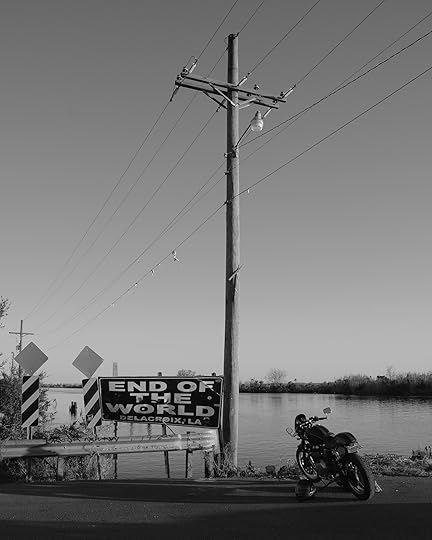 Virginia Hanusik, Sign in Delacroix, St. Bernard Parish, 2020
Virginia Hanusik, Sign in Delacroix, St. Bernard Parish, 2020  Virginia Hanusik, Lake Maurepas after Hurricane Ida, 2022
Virginia Hanusik, Lake Maurepas after Hurricane Ida, 2022 “Architecture is endlessly expressive,” Hanusik told me. In the places she visited, “there [are] a lot of funky, interesting ways that people make their own personalities.” Some houses are conventional tongue and groove, raised on marine pilings or cinder blocks, while others, like the Irish Bayou Castle, are eccentric and even strange. Over time, she found that it was this relationship between the people and the landscape that helped her understand “why Louisiana is the way it is now.”
During her drives south through Plaquemines Parish down to Venice or west toward Houma and then down to Port Fourchon, Hanusik started to make photographs, largely of the architecture she encountered: raised homes, vernacular buildings, and the omnipresent traces of engineering projects that attempt to contain the water. Into the Quiet became something much deeper than just a record. It’s a project, she writes in the book, “dedicated to complicating disaster-oriented narratives and the imagery and imaginations that come with them. It is a book about multiple truths existing at once, about looking at the light and the dark and that which meanders between.”
 Virginia Hanusik, Houseboat on Lake Maurepas, 2015
Virginia Hanusik, Houseboat on Lake Maurepas, 2015Into the Quiet, published by Columbia Books on Architecture and the City, opens with Harold Fisk’s maps of the oxbows of the Mississippi River, reproduced on the endpapers. After an introduction by Hanusik, her photographs punctuate a collection of essays, reflections, and poems about the region by a diverse group of contributors. The photographs are straightforward and filled with detail, and Hanusik’s own written contributions—among the book’s most compelling aspects—consider landscape painting, connotations of the swamp, and the privileging of certain communities over others in the form of flood mitigation. At times her writing veers toward academic, but it also brilliantly weaves together disparate sources like Louise Glück, the U.S. Army Corps of Engineers, and Robert Adams, from whose 2010 exhibition text for Gone? Colorado in the 1980s she borrowed the book’s title.
 Virginia Hanusik, Mississippi River-Gulf Outlet, Shell Beach, 2023
Virginia Hanusik, Mississippi River-Gulf Outlet, Shell Beach, 2023  Virginia Hanusik, Marsh Cows Near Venice, Plaquemines Parish, 2022
Virginia Hanusik, Marsh Cows Near Venice, Plaquemines Parish, 2022 Hanusik’s photographs are layered with myriad voices describing their relationship to South Louisiana, revealing how it belongs as much to African culture as it does to European, and speaking clearly to the legacy of chattel slavery and the migration of Southeast Asian immigrants in the wake of the Vietnam War and the Khmer Rouge regime. The photographs are deceptively simple but thoughtful representations of a place shaped by weather and many overlaid strands of culture. “At the core of the project,” she writes, “is an effort to encourage thinking of this region—and coastal communities around the country—as an interconnected system rather than as separate and expendable landscapes.”
 Virginia Hanusik, The Great Wall of Louisiana No. 2, 2022
Virginia Hanusik, The Great Wall of Louisiana No. 2, 2022All photographs courtesy the artist
I asked Hanusik what it felt like to see Into the Quiet in physical form, to see the end of a decade of work. “There’s some emotional element there that maybe I haven’t been able to fully articulate,” she said. “But it’s a place that I love very much, feel connected to, and I don’t think that will ever go away.” Yet, the cruel irony is that since she first moved to New Orleans, the Louisiana coast has lost around 350 square miles of land. Everyone who loves this part of the country claims some part of that collective grief as an area the size of Manhattan disappears each year. For Hanusik and her collaborators, that grief has often transformed into something else. As she said, “I just have such a deep respect for the ways that Louisianans have lived with water for generations.”
Into the Quiet and the Light: Water, Life, and Land Loss in South Louisiana was published by Columbia University Press in 2024.
September 5, 2024
Deana Lawson Guest Edits Aperture Magazine’s Fall Issue
This fall, Aperture publishes “Arrhythmic Mythic Ra,” an issue guest edited by Deana Lawson that refracts themes of family, social history, and the astrophysical through a selection of surprising and illuminating images by photographers from the past and present.
“It seems the photographs that I’m most drawn to in my conscious looking life push against our preconceived notions of social and aesthetic norms, images that are abrasive to our tastes, that make our model of the world more complicated,” Lawson writes.
 Aperture Magazine Subscription 0.00 Get a full year of Aperture—the essential source for photography since 1952. Subscribe today and save 25% off the cover price.
[image error]
[image error]
Aperture Magazine Subscription 0.00 Get a full year of Aperture—the essential source for photography since 1952. Subscribe today and save 25% off the cover price.
[image error]
[image error] 
In stock
Aperture Magazine Subscription $ 0.00 –1+ View cart DescriptionSubscribe now and get the collectible print edition and the digital edition four times a year, plus unlimited access to Aperture’s online archive.
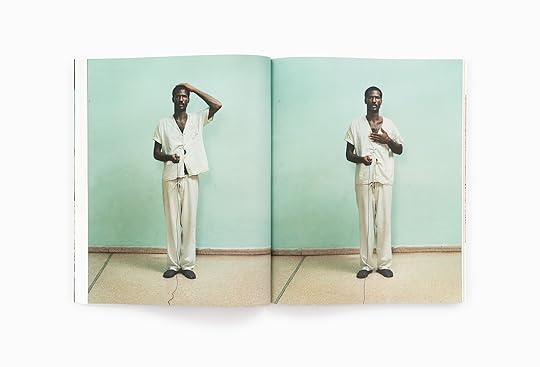 Spread from Aperture, Fall 2024, with photographs by Adam Broomberg and Oliver Chanarin
Spread from Aperture, Fall 2024, with photographs by Adam Broomberg and Oliver Chanarin 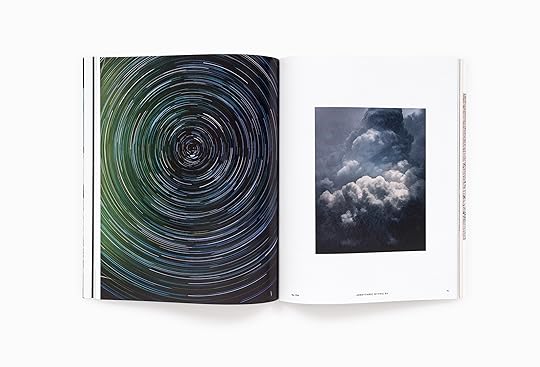 Spread from Aperture, Fall 2024, with photographs by Trevor Paglen
Spread from Aperture, Fall 2024, with photographs by Trevor Paglen “Photography, the outlier, is most adept at reminding us of instability and fallibilities,” Lawson notes. “I believe we all need to observe things we don’t understand. And as someone who makes pictures, I’m reminded that a photograph, by its nature, can deliver more about the subject than even the photographer or the subject intend. With this in mind, I have arranged a constellation of images that operate like texts and texts that operate like pictures—fragmented, arrhythmic, mythic.”
“Arrhythmic Mythic Ra” features the work of more than thirty photographers—including Berenice Abbott, Bruce Davidson, LaToya Ruby Frazier, Balarama Heller, Arthur Jafa, Kikuji Kawada, Sally Mann, Louis Mendes, Boris Mikhailov, and cover artist Lieko Shiga—alongside new poetry by renowned authors Ben Okri, Tracy K. Smith, and Simone White; an essay by economic anthropologist Jason Hickel; and a short story by artist Jeff Whetstone.
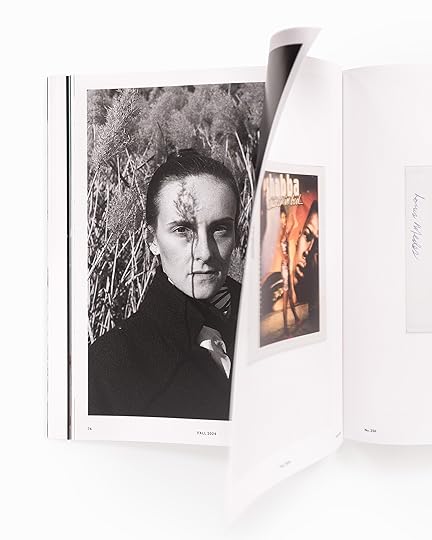 Spread from Aperture, Fall 2024, with photographs by Seiichi Furuya, Louis Mendes, and Deana Lawson
Spread from Aperture, Fall 2024, with photographs by Seiichi Furuya, Louis Mendes, and Deana Lawson 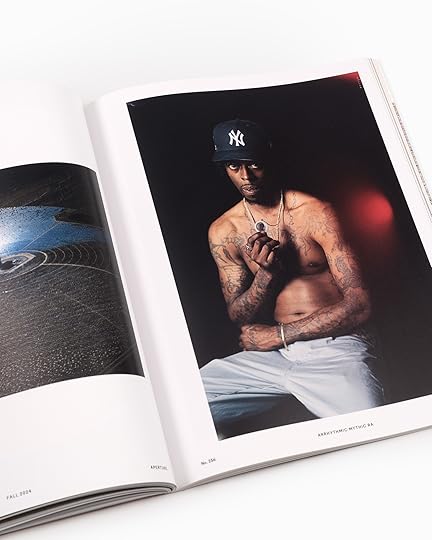
“Lawson’s approach to reading photographs is wholly distinct and fresh. She has organized a surprising and enigmatic collection of images and texts for this special issue. It is very much an artist’s project in magazine form,” says Michael Famighetti, Aperture’s editor in chief.
The issue coincides with Poetic Record: Photography in a Transformed World, an exhibition and two-day symposium at Princeton University, where Lawson is professor of visual arts. The exhibition is curated by Lawson and Famighetti, and the symposium is organized by Lawson in collaboration with Princeton colleagues Jeff Whetstone and James Welling at the Hurley Gallery, Lewis Center for the Arts. The show, on view from October 1 to December 5, 2024, includes work by many photographers featured in “Arrhythmic Mythic Ra.” The symposium takes place from October 10 to 11.
See more in Aperture No. 256, “Arrhythmic Mythic Ra.”
August 29, 2024
The Exhibitions That Transformed African Photography
“The history of Europe in the past few centuries is an African history, whether one likes it or not,” the curator Simon Njami writes in the catalog for Africa Remix: Contemporary Art of a Continent. The landmark exhibition opened in Düsseldorf, Germany, in 2004, before traveling to London, Paris, Tokyo, Stockholm, and—amazingly, given the rarity of exhibitions about Africa originating in the global north ever travelling to the continent—Johannesburg. “Just as African history,” he adds, “is resolutely European.”
Implicit in Njami’s proposal about the continents’ entangled histories is an understanding that curatorial work is also history, that curators are also historians; like West Africa’s griots, custodians of oral histories, the curator-historian uses eccentric methods to reach provocative conclusions. Twenty years later, Africa Remix stands as a record of an era’s preoccupations and artistic statements. But does it hold up?
The catalog arrived amid a groundswell of Euro-American interest in contemporary African photography, spurred by the 1990s-era Bamako and Dakar biennials and the invaluable archival work of Revue Noire, the quarterly magazine Njami cofounded and edited. Collectively, these projects contributed to the wider reception of West African photographers like Mama Casset, Seydou Keïta, and Malick Sidibé, who were active between the 1950s and ’70s, as well as Cameroonian-born Nigerian photographer Samuel Fosso, who developed an inventive artistic practice of staged self-portraiture, beginning in the mid-’70s.
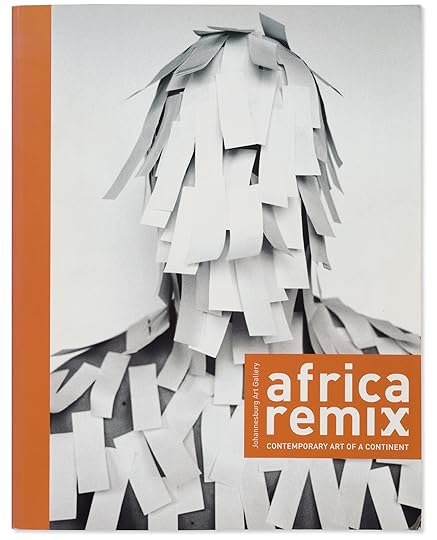 Cover of Africa Remix: Contemporary Art of a Continent (Jacana Media, 2007)
Cover of Africa Remix: Contemporary Art of a Continent (Jacana Media, 2007) 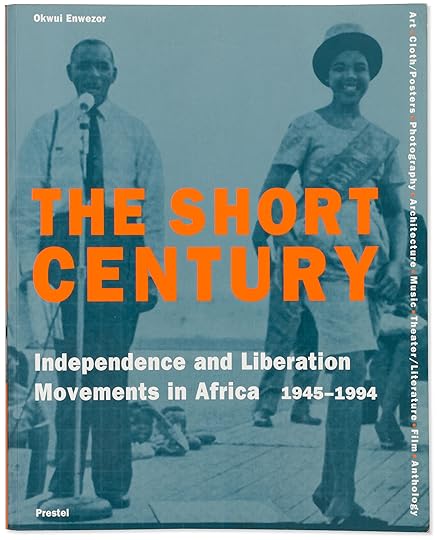 Cover of The Short Century: Independence and Liberation Movements in Africa, 1945–1994 (Prestel, 2001)
Cover of The Short Century: Independence and Liberation Movements in Africa, 1945–1994 (Prestel, 2001) Whereas painting is now at the vanguard of African creativity, both in the art market and in museums, photography was the zeitgeist medium across Africa in the early 2000s. As in Africa Remix, it featured prominently in two similarly photo-interested traveling exhibitions, both overseen by the late Nigerian American curator Okwui Enwezor: The Short Century: Independence and Liberation Movements in Africa, 1945–1994, which opened in Munich in 2001, and Snap Judgments: New Positions in Contemporary African Photography, which launched in New York in 2006.
Less experimental and more obviously anthropological than Njami’s exhibition, The Short Century presented an overdue engagement with African modernity through work by fifty artists from twenty-two African countries. A ranging and analytical curator, Enwezor organized the historical objects around seven subject areas: modern and contemporary art, film, photography, graphics, architecture/space, music/recorded sound, and literature and theater, all linked to an historical framework. Snap Judgments was a less dialectical affair—only just. Composed of recent conceptual, documentary, and fashion photography, the show proposed that the “rigorous analytical perspective” of the thirty-four artists and one collective featured was expanding the lexicon of African art.
 Installation view of Snap Judgements: New Positions in Contemporary African Photography, International Center of Photography, New York, 2006, with photographs by Kay Hassan and Allan deSouza
Installation view of Snap Judgements: New Positions in Contemporary African Photography, International Center of Photography, New York, 2006, with photographs by Kay Hassan and Allan deSouza© International Center of Photography
Exhibitions, especially large group exhibitions, typically open with great fanfare, and then begin to weaken and atrophy, in varying increments depending on the strength of their visual arguments, until their memory can appear hazy, imprecise, in need of recall—arguably a key labor of the catalog.
Africa Remix, The Short Century, and Snap Judgments are all memorialized with doorstoppers. When they first appeared, these hefty and increasingly hard-to-find books represented important contributions to knowledge about African photography. They also updated the arguments that had been staged in two vital 1990s publications: the Guggenheim Museum’s In/Sight: African Photographers 1940 to the Present (1996), which includes a compass-setting essay by Enwezor, and Revue Noire’s Anthology of African and Indian Ocean Photography (1999), which features multiple contributions on individual photographers by Njami.
Enwezor’s and Njami’s focus on photography in the early 2000s was guided by their activism, yet their perspectives on photography and rhetorical styles also reflect their respective apprenticeships in New York and Paris. After studying politics at Jersey City State College in the early 1980s, Enwezor dove headlong into poetry (notably performing at the Nuyorican Poets Café), before emerging as an outspoken art critic interested in postcolonial identity, plurality, whiteness, and the endurance of western cultural hegemony. Njami too had literary ambitions, publishing four novels in the 1980s, before establishing himself as a rambunctious critic, who in 1991 told Senegalese filmmaker Djibril Diop Mambety, “I hate photography.”
Explaining Africa in the museums of the global north is a longstanding activity, freighted by a history of colonial encounter and subjugation.
As a writer, Njami is temperamentally and attitudinally very different from Enwezor. His rhetorical mode in Africa Remix is provocative (“Africa is a scandal . . . a continent in constant mutation . . . without doubt the kingdom of immateriality”) and philosophical (“Different forms of contemporaneity coexist without necessarily echoing each other). To resist the homogenizing tendencies of European exhibitions on Africa art, Njami organized the sculpture, video, installation, and painting into three thematic groupings: identity and history, body and soul, city and land. A quarter of the artists on view used photography as their primary medium; yet, strangely, Njami barely discusses photography in his essay.
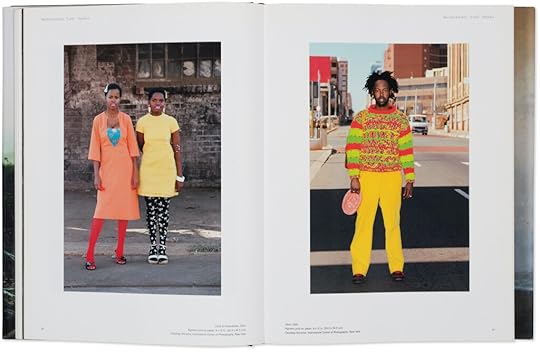 Spread from Snap Judgments: New Positions in Contemporary African Photography (ICP/Steidl, 2006), with photographs by Nontsikelelo Veleko
Spread from Snap Judgments: New Positions in Contemporary African Photography (ICP/Steidl, 2006), with photographs by Nontsikelelo VelekoEnwezor, particularly in Snap Judgments, is far more persuasive about the evolution and arc of African photography at the start of the new century. Noting the increasingly analytical mode of recent work, he writes, “the new position the artists adopt engages broader spheres of interest such as landscape, urban studies, performance, portraiture, and documentary, differing from earlier approaches.”
History informs the thinking of both Njami and Enwezor as curators, and an historical perspective is ever-present in their work as writers (“To broach contemporaneity in Africa,” writes Njami in his Africa Remix essay, “inevitably leads to a re-reading of history”). Their cosmopolitan ethos and genre-spanning approaches were shaped by the presentation of Africa in Paris and New York, in particular “Primitivism” in 20th Century Art: Affinity of the Tribal and the Modern (1984), a controversial New York exhibition pairing classical African art with examples of high modernist European painting and sculpture, and Magiciens de la terre (1989), an equally charged Paris exhibition that juxtaposed established Western artists such as John Baldessari and Louis Bourgeois with a broad constituency of non-Western folk artists, crafters, shamans, priests, and hard-to-classify visionaries like Frédéric Bruly Bouabré and Bodys Isek Kingelez (each of whom would have posthumous solo exhibitions at the Museum of Modern Art, New York).
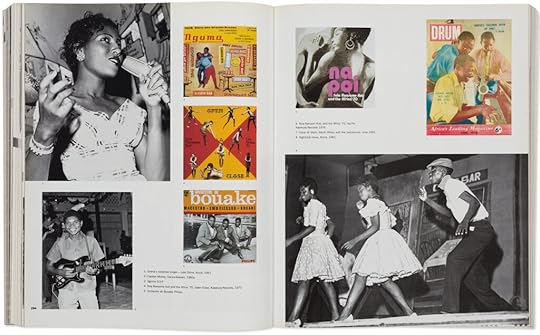 Spread from The Short Century: Independence and Liberation Movements in Africa, 1945–1994 (Prestel, 2001), with a cover of Drum magazine, photographs, and album covers from the 1950s–70s
Spread from The Short Century: Independence and Liberation Movements in Africa, 1945–1994 (Prestel, 2001), with a cover of Drum magazine, photographs, and album covers from the 1950s–70sShowcasing and explaining Africa in the museums of the global north is, of course, a longstanding activity, freighted by a history of colonial encounter and subjugation, but also informed by different traditions of art scholarship and literary style. Njami, who was born in Lausanne, Switzerland, thinks and writes in the intellectual mode of Baldwin, Sartre, and Senghor, balancing activism and rhetoric with an acute literary style, while Enwezor—a refugee of the Biafran War, a circumstance mentioned in his Snap Judgments essay—was a quintessential New York intellectual gripped by the ideas of Agamben, Derrida, and Glissant, philosophers who informed his logical precision and ethical ambition as a writer.
Njami is far more playful and epigrammatic than Enwezor, who jettisoned his argumentative style of the early 1990s in favor of method, reason, and flashes of lyrical brilliance that connected his practice to the history work of griots. In his essay in Short Century, for instance, he quotes a passage from Martinican writer and politician Aimé Césaire’s epic poem, Notebook of a Return to a Native Land (1939), when a mutiny on a slave ship causes it to crack apart and reveal the “ghastly tapeworm of its cargo.” In response, he writes: “Like the cracking of the slave ship, the relationship of African modernity to Europe’s construction of the universal subject is both a critique and modification, a rip in the body of the colonial text.”
Catalogues are opportunities not only to read but also to look. Snap Judgments features an untitled 2003 portrait of a cane worker by Zwelethu Mthethwa on its cover. A leading figure in South Africa’s early post-apartheid photography scene (evidenced by his appearance in Africa Remix and The Short Century, too) Mthethwa was incarcerated in 2017 for a violent murder committed four years earlier. By then, African photography’s critical moment had also seemingly passed, although the Rencontres de Bamako, the biennial of African photography established in Mali in 1994, continued intermittently to present exhibitions of photography, as did spaces such as the Centre for Contemporary Art in Lagos and RAW Material in Dakar. Still, figurative painters like Marlene Dumas and Kerry James Marshall, who appeared in Enwezor’s 2015 Venice Biennale, defined the new zeitgeist.
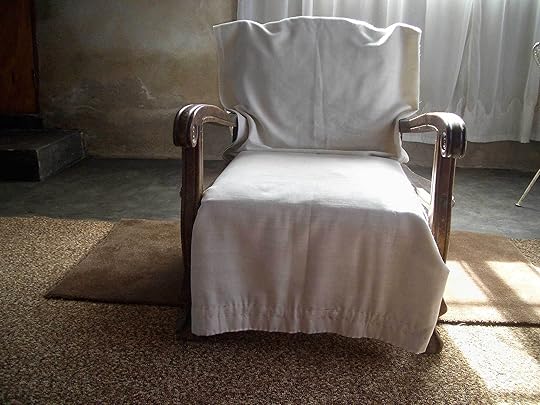 Moshekwa Langa, Untitled XXI, 2005
Moshekwa Langa, Untitled XXI, 2005Courtesy Stevenson, Cape Town and Johannesburg
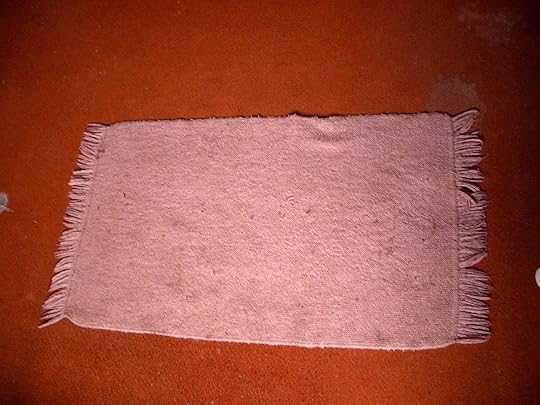 Moshekwa Langa, Untitled XII, 2005
Moshekwa Langa, Untitled XII, 2005 Only two other artists appeared in all three exhibitions: Moshekwa Langa and Zarina Bhimji, who like Mthethwa were South African. For a period in the 1990s and early 2000s, South Africa was a site for ambitious exhibition making. Africa Remix opened at the Johannesburg Art Gallery, a century-old municipal museum, in 2007. The date is at the midpoint between Enwezor’s stellar curatorship of the second Johannesburg Biennale, in 1997, and the 2015 presentation in Johannesburg of his exhibition Rise and Fall of Apartheid: Photography and the Bureaucracy of Everyday Life, which, like Snap Judgments, originated at the International Center of Photography.
For South Africans, Africa Remix presented a rare opportunity to see the work of local photographers in conversation with works by the likes of Akinbode Akinbiyi, Yto Barrada, Hicham Benohoud, and Jellel Gasteli. It also provided an opportunity to test the veracity of the negative reviews Africa Remix generated in London in 2005. Brian Sewell, a neoconservative critic in the tradition of Hilton Kramer, described Njami’s exhibition as a “wretched assembly of post tribal artifacts”—and much worse. Perplexed by Njami’s thematic focus on urban Africa and strong preference for lens-based media, Jonathan Jones told Guardian readers, “Africa Remix misdescribes the continent.” The exhibition represented the view of “city-dwelling elites” Jones reported back to his constituency of, yes, city-dwelling elites.
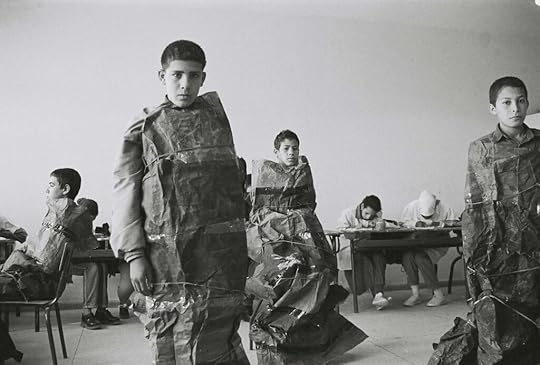 Hicham Benohoud, La salle de classe (The classroom), 1994–2001
Hicham Benohoud, La salle de classe (The classroom), 1994–2001Courtesy the artist
Although it remains the least urbanized continent on the planet, in 2005, Africa had forty-three cities with more than one million inhabitants. Writing a year earlier in his magnum opus, For the City Yet to Come: Changing African Life in Four Cities (2004), urban theorist AddouMaliq Simone argued: “In city after city, one can witness an incessant throbbing produced by the intense proximity of hundreds of activities: cooking, reciting, selling, loading and unloading, fighting, praying, relaxing, pounding.”
Both Enwezor and Njami were keen to show this proximity. In his introduction to the section of photos grouped under “city and land” in Africa Remix, Njami leans into this cliché of a rural continent (“The city is a recent concept in Africa”), and then promptly detonates it by emphasizing the extraordinary volume of work about African cities (“Showing the city is never gratuitous”). Enwezor too was interested in the metropolitan subjectivity and focus of new African photography. “A large selection of Snap Judgments brings together studies of urban sites,” writes Enwezor, who was interested in how the work of Barrada, Kay Hassan, and the collective Depth of Field (founded in 2001 by Nigerians Kelechi Amadi-Obi, Uchechukwa James-Iroha, Toyin Sokefun and Amaize Ojeikere, the son of studio photographer J.D. Okhai Ojeikere), among others, addressed “modes or urban living and the changes that shape the postcolonial metropolis.”
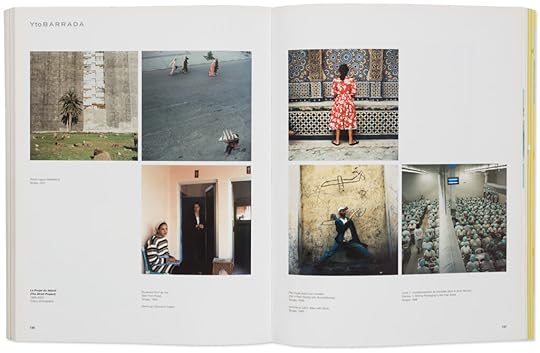 Spread from Africa Remix: Contemporary Art of a Continent (Jacana Media, 2007), with photographs by Yto Barrada
Spread from Africa Remix: Contemporary Art of a Continent (Jacana Media, 2007), with photographs by Yto BarradaAll book photographs by Mia Thom
Africa Remix’s arrival in Johannesburg inspired the production of an updated (and also more affordable) edition of the original 2005 catalog. Both editions prominently foreground photography: Samuel Fosso’s vibrant color self-portrait, The Chief Who Sold Africa to the Settlers (1997), features on the cover of the first edition, while a black-and-white self-portrait from Moroccan photographer Hicham Benohoud’s series Version Soft (2003) adorns the later version, which includes new essays by philosopher Achille Mbembe and JAG director Clive Kellner. “This is the first time a major exhibition of contemporary African art will be held in Africa,” writes Kellner in a preface. This is not true. What he meant to say was that it was one of the first times a major Western exhibition of any art, let alone African art, visited the continent.
“There have been many, in recent years almost too many, great exhibitions of African art in Europe and in America,” writes Frank McEwen, the charismatic and worldly director of Rhodes National Gallery (now National Gallery of Zimbabwe), in the catalog accompanying the First International Congress of African Culture in 1962. Held in Harare, the accompanying exhibition explored ideas rehearsed in “Primitivism” in 20th Century Art and Magiciens de la terre, more than two decades later. It was high time, ventured McEwen, “that African art were shown more often in Africa, and reclaimed culturally by its creators.”
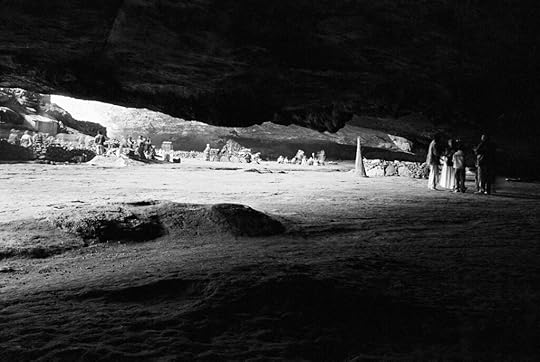 Santu Mofokeng, Inside Motouleng Cave, Clarens, 1996
Santu Mofokeng, Inside Motouleng Cave, Clarens, 1996© Santu Mofokeng Foundation and courtesy Lunetta Bartz, MAKER, Johannesburg
That possibility was not an abstraction. In 1958, Edward Steichen’s large-scale photo exhibition, The Family of Man, was presented in Johannesburg. Photographer Peter Magubane, whose early Drum-era work is illustrated in the catalogue for The Short Century, attended the exhibition. “I began working very, very hard to try and reach the standard of those pictures that I saw,” Magubane told photographer Ken Light. Magubane’s statement is a caution against lionizing the role of curators simply or only as historians involved in the production of revisionist texts. Exhibitions are embodied and experiential; seeing an exhibition in person, more so than reading about its ambitions after the fact, is a privileged occasion to pause, think, maybe learn, possibly even aspire.
August 22, 2024
An Ardent Observer of Beirut
This article originally appeared in Aperture, Winter 2023, “Desire,” under the column Dispatches.
Tanya Traboulsi is an ardent observer of the Lebanese coastline. Her photographs probe the ways in which clay tennis courts and fake grass playing fields are tucked into the hills sliding down to the sea in Ras Beirut, on the western side of the city’s promontory. She is also a dedicated student of vernacular architecture. She details vestibules, awnings, bougainvillea peeking through tactical breeze-blocks, and the elegant arches of a derelict Ottoman mansion. She returns again and again to the playfulness with which shopkeepers in the Lebanese capital use language to advertise the Renaissance Sporting Club, New Fashion, or Dalida, a tiny chocolatier downgraded under financial duress to an all-purpose dekaneh, or grocery store, named for a pop music sensation.
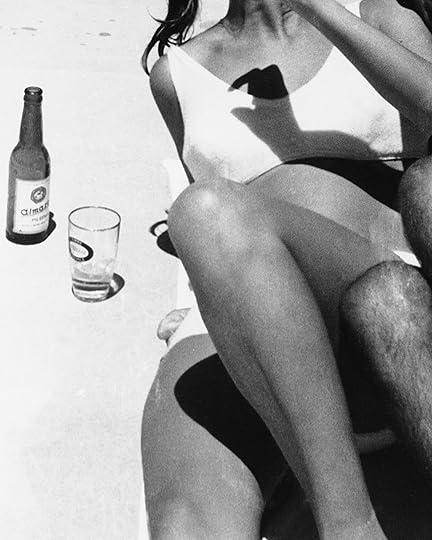
Traboulsi’s series Beirut, Recurring Dream (2021–ongoing) pairs photographs she has taken in the last two years with images from her personal archive: six large boxes of material, including family albums and pictures she took during her childhood and adolescence. Traboulsi’s diptychs are fluid and unfixed. They appear in different configurations, depending on their context. They are also matched by intuition. By placing a photograph of a couple lounging on a beach in the 1960s next to an image of a woman standing alone, her back to the viewer, on the corner of a low wall jutting into the sea, as she gazes toward a blurry horizon and ambivalent skies, Traboulsi isn’t suggesting narrative so much as time travel or a flash of inherited memory.
Traboulsi was seven years old when she left Beirut with her family on a boat crossing the Mediterranean Sea. It was 1983. Lebanon’s civil war was lurching through its first decade. The center of the capital had been destroyed in the first round of fighting, starting in 1975. Beirut was split in half and the armed forces had fractured. The government was about to collapse. Massacres had occurred all over the country, and there was shelling in densely residential neighborhoods. Syria had intervened, and in 1982, Israel had invaded and besieged the country, which, among other things, closed the airport for months at a time. Fleeing residents had to risk dangerous mountain roads or the ferry lines connecting Beirut to Cyprus.
As a city, Beirut has been photographed with a prodigiousness disproportionate to its size, even its history.
Traboulsi’s parents met before the civil war began. Her mother had moved to Lebanon from Vienna to work as a ski instructor, and Traboulsi’s father cut the line to sit with her on the lift. An enduring romance ensued. Traboulsi was born in Austria but spent her early years in Beirut, taking pictures of the city using an Instamatic camera and 110 film. Her family left and stayed away for more than a decade, in part because the civil war lasted so long and in part because it ended with such uncertainty. A general amnesty was announced in 1991, although some argue the conflict continued by other means.

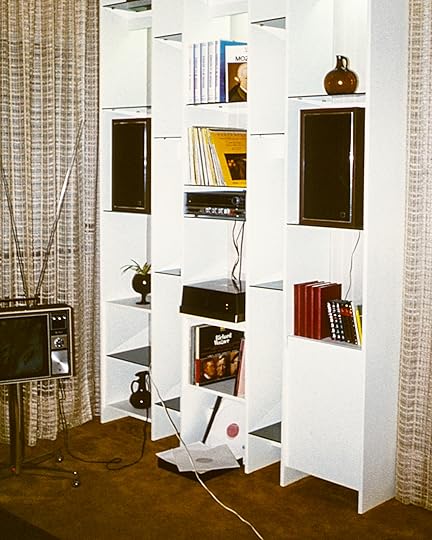
“The moment I left, I wanted to go back,” Traboulsi told me this past summer. “The image of how Beirut looked from the sea stuck with me for thirteen years.” She was separated from her two best friends in Lebanon and saw them constantly in her dreams. She didn’t return until 1996. From that point, she shuttled back and forth between Austria and Lebanon until she finished university. She settled in Beirut in 2003.
As a city, Beirut has been photographed with a prodigiousness disproportionate to its size, even its history. The so-called photographic mission of 1991 invited six leading photographers—Gabriele Basilico, Raymond Depardon, Fouad Elkoury, René Burri, Josef Koudelka, and Robert Frank—to document the tremendous violence done to the heart of Beirut’s city center by fifteen years of civil war. In the late 1990s and early 2000s, artists and filmmakers such as Walid Raad, Jalal Toufic, and Akram Zaatari responded to the conditions of postwar and reconstruction-era Beirut with their own trenchant questions. In their wake, Traboulsi has emerged as one of the city’s most thoughtful and affectionate chroniclers.
Related Items
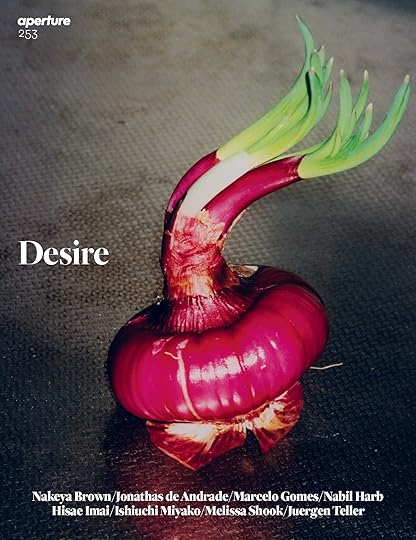
Aperture 253
Shop Now[image error]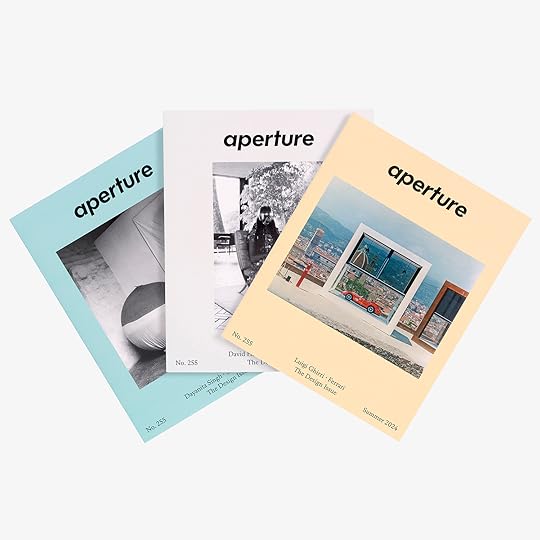
Aperture Magazine Subscription
Shop Now[image error]Traboulsi and I are nearly the same age and came to live in Beirut at the same time. In many ways, her photographs narrate my own relationship to the city. She has photographed buildings I have lived in, corners I have loved, places I have walked by and wondered about daily. I vividly remember my first encounter with her work, in a group show called Be-Sides: How Young Lebanese Photographers See Present-Day Lebanon, organized by the Goethe-Institut in 2007.
Beirut’s photographic history can make the city feel trapped in the past, forever in the rubble of the civil war. But Traboulsi has stayed with the story and followed the city through more recent upheavals. With great subtlety and sensitivity, in Beirut, Recurring Dream she gathers traces of the revolution that erupted in 2019, followed by the economic collapse that devalued the local currency by 90 percent and plunged more than half the country into poverty. She captures the afterlives of the catastrophic explosion that ripped through the port of Beirut on August 4, 2020, killing hundreds, injuring thousands, and displacing three hundred thousand people from their damaged homes.
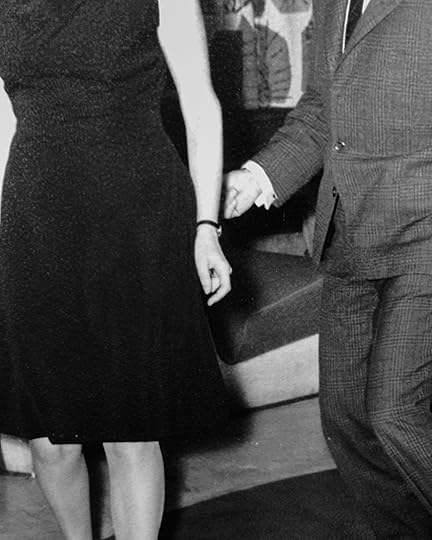 All photographs by Tanya Traboulsi, from the series Beirut, Recurring Dream, 2021–ongoing
All photographs by Tanya Traboulsi, from the series Beirut, Recurring Dream, 2021–ongoingCourtesy the artist
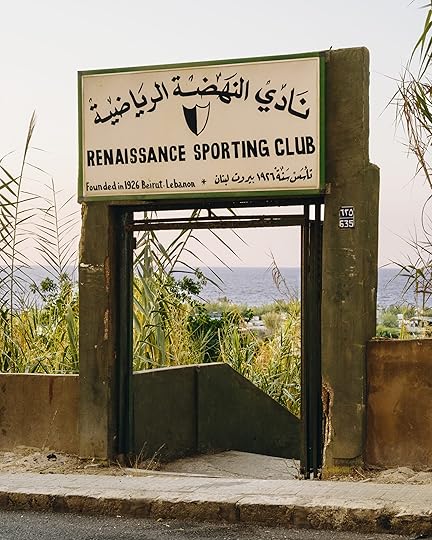
“The explosion changed everything,” Traboulsi told me. “It changed me, my friendships, my relationships, my view of love, what I accept and what I can give to other people.” Seeing the city so damaged compelled her to admit that Beirut was and always had been her subject.
The Lebanese poet Etel Adnan described a mountain in California as her best friend. She painted it every day, in all kinds of light and weather, for more than a year. This was in the mid-1980s, after Adnan, the ultimate chronicler of Beirut, had made her own exit from the city and Lebanon’s civil war. In 2021, Traboulsi made a film with the writer Ibrahim Nehme, unrelated to Beirut, Recurring Dream, called Son of the Sun. Nehme’s voiceover offers a visceral response to the port explosion (he was seriously injured in the blast), but Traboulsi’s images are long, steady shots of the sun rising and falling on the coastline, waves lapping the shore. Adnan had her mountain, Traboulsi has her city on the sea.
This article originally appeared in Aperture, Winter 2023, “Desire.”
Aperture's Blog
- Aperture's profile
- 21 followers



